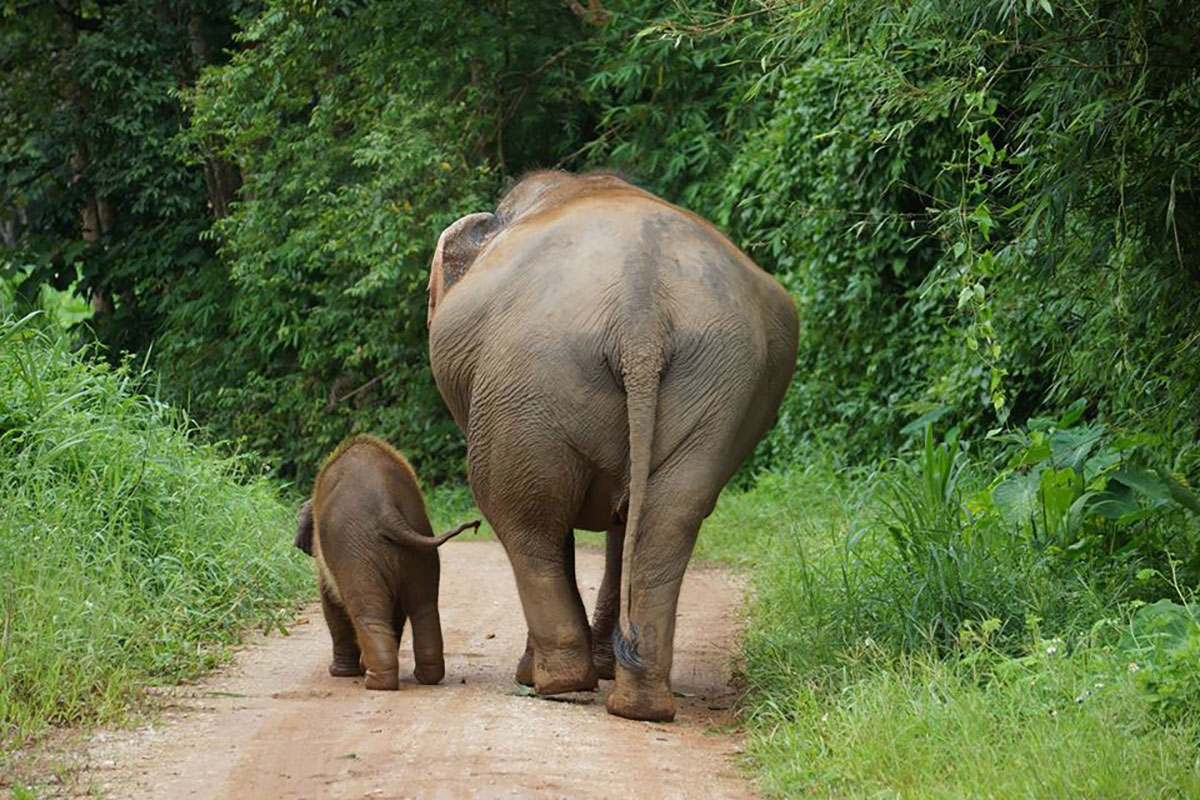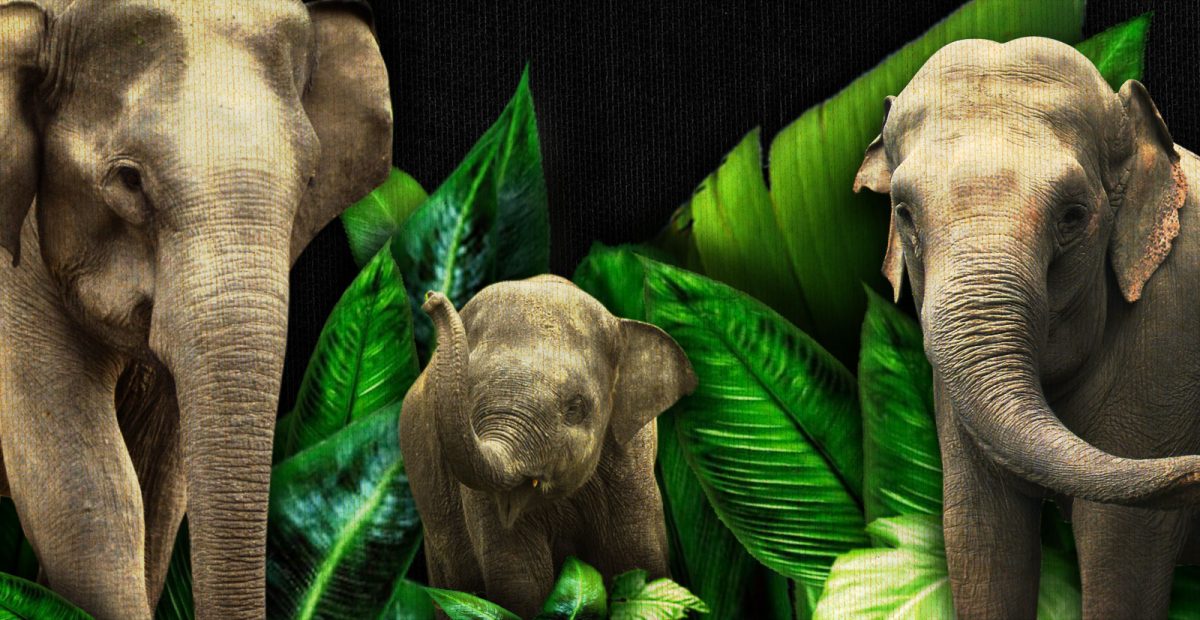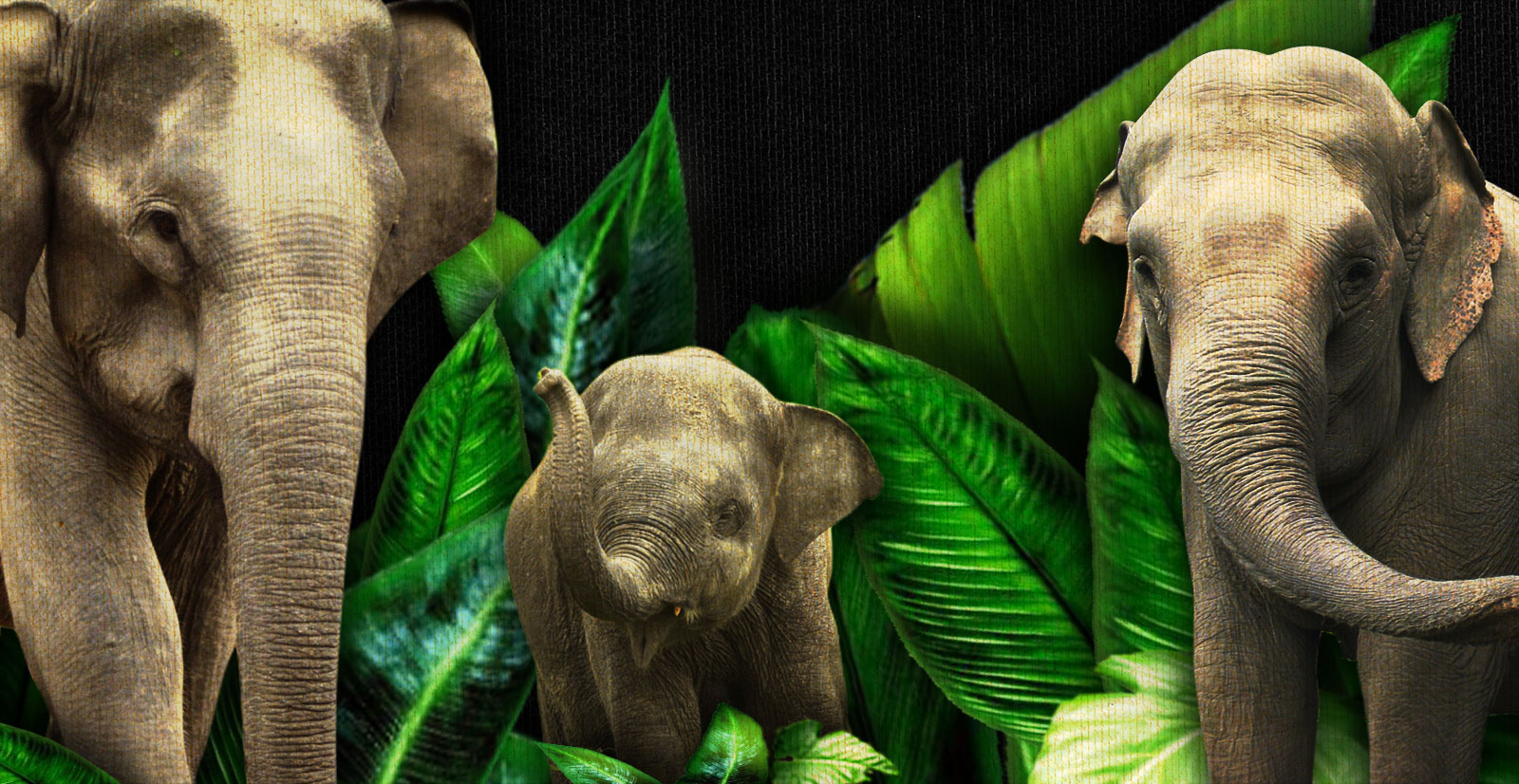
Current Situation
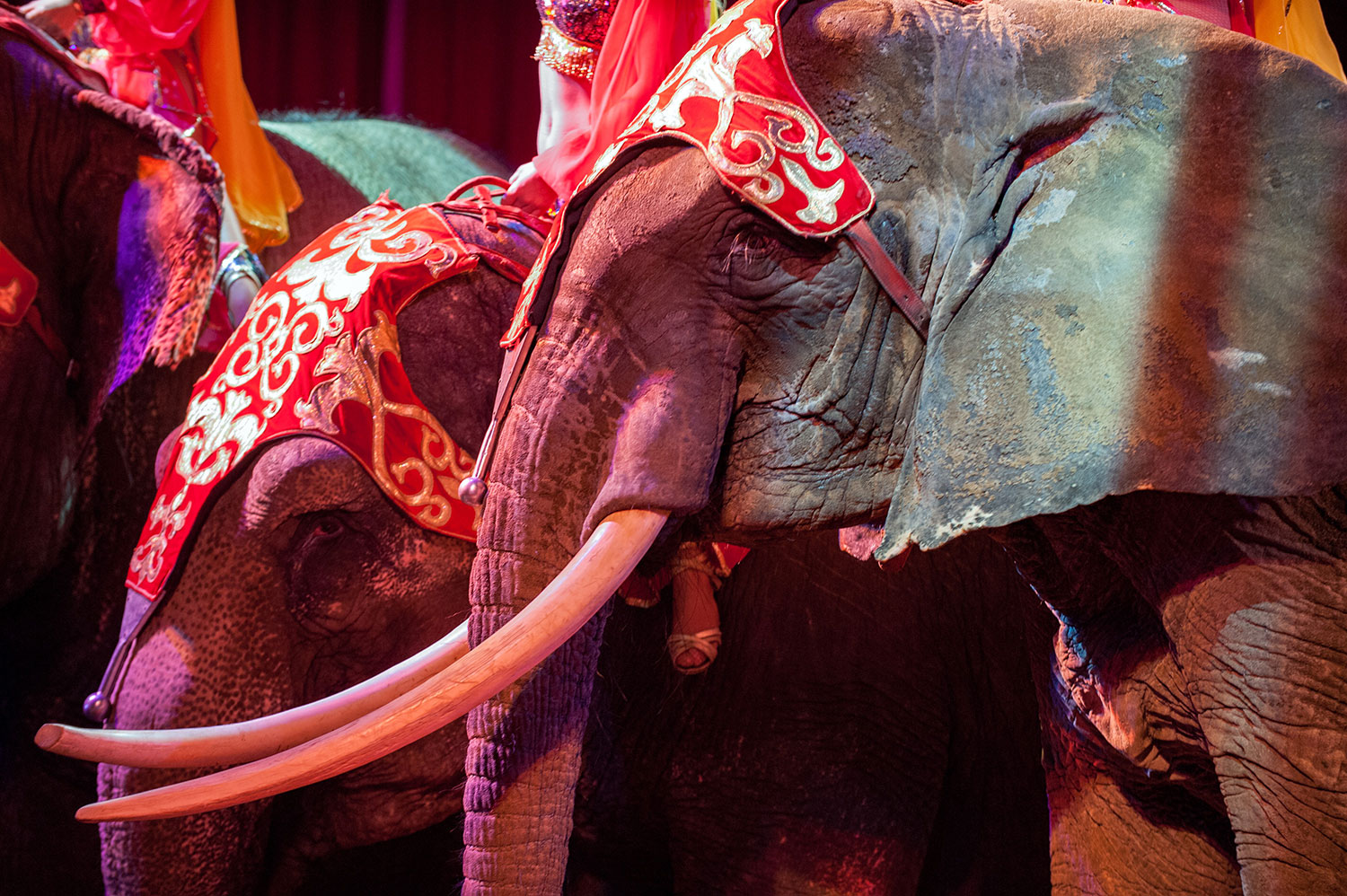
One of the main reasons that people go to the circus is to see animals. In fact, most people who attend the circus love animals, and they take their children for the same reason—to marvel at the magnificence of amazing creatures they would never encounter in real life. But behind the spectacle and illusion is a heartbreaking reality no animal lover would ever knowingly support: animals used by circuses are physically and emotionally abused, and they lead lives of tremendous suffering. There is perhaps no better example of this than the treatment of the majestic Asian elephant.
Elephants in the wild do not stand on their heads, balance on pedestals, or allow themselves to be mounted and ridden around by other animals
The acts that elephants perform in the circus are not natural behaviors and make no sense to these intelligent animals. Elephants in the wild do not stand on their heads, balance on pedestals, or allow themselves to be mounted and ridden around by other animals. Circus tricks are confusing and stressful for elephants, and their repeated performance is achieved only by subjecting these animals to continual violence and intimidation.
Broken Spirits

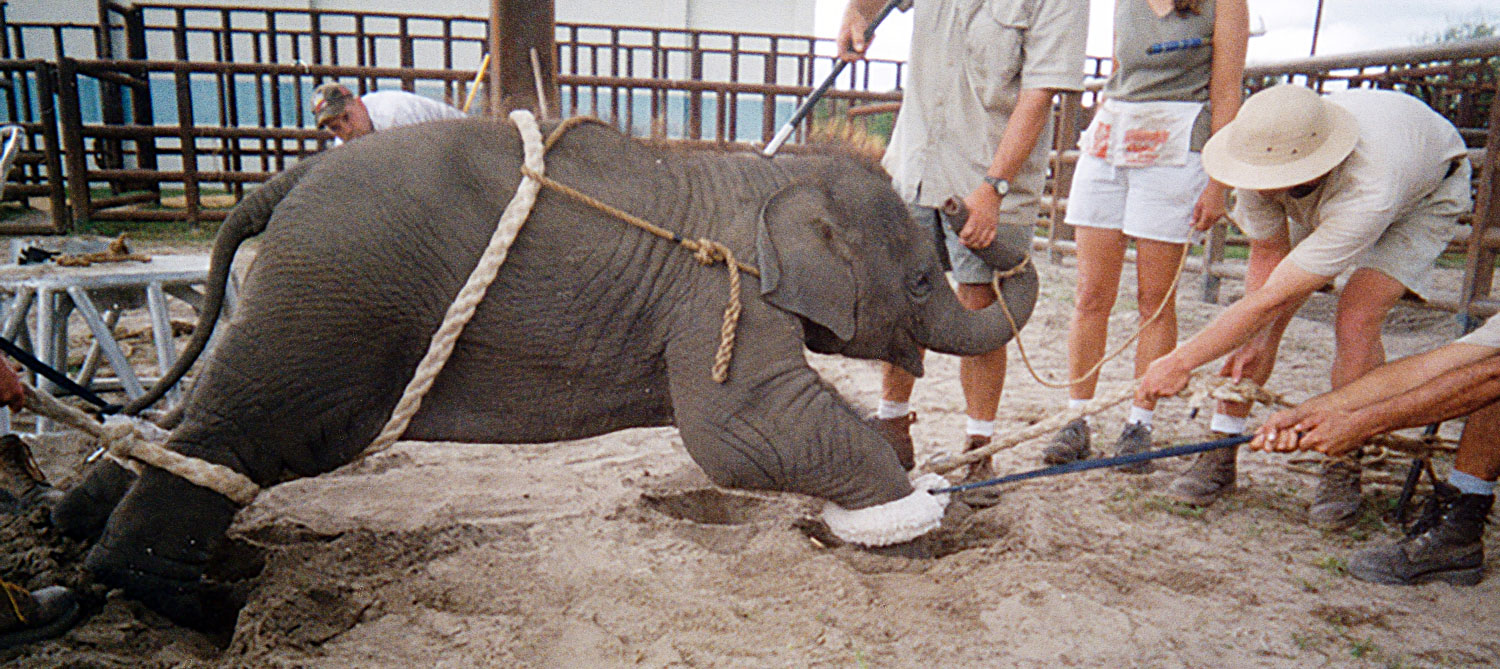
Most elephants used by circuses are captured in the wild; some are born on breeding farms. In both cases, baby elephants are taken from their mothers and chained indoors until their spirits have been completely broken. A former Ringling employee described forcibly removing elephants from their mothers at only one year of age. Separation involves pulling the baby’s legs with ropes, and tethering the baby by the neck to an adult elephant who is prodded to drag him away from his mother. In addition to emotional trauma, babies frequently suffer rope burns and lesions during this process.
The young elephants are then chained by their legs indoors for up to 23 hours a day, until they have lost all hope and the will to fight
The young elephants are then chained by their legs indoors for up to 23 hours a day, until they have lost all hope and the will to fight. Breaking their spirits can take anywhere from several weeks to six months, during which time baby elephants may receive as little as 40 minutes of exercise a day, spending the rest of their time in confinement.
Once broken, they are repeatedly subjected to violent training sessions in which bullhooks (elephant-training tools that resembles fireplace pokers) and electric shock are used to make them cooperate; they learn their tricks from pain and fear. Many baby elephants have died in circuses as a result of injuries, mistreatment, and neglect.
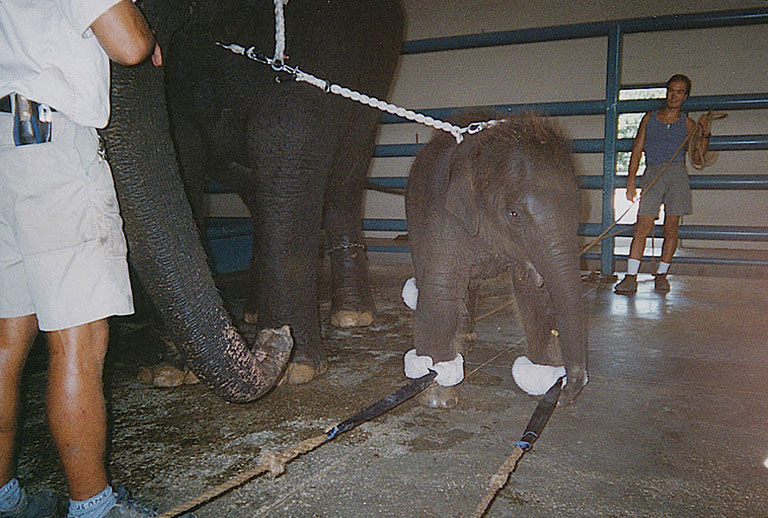
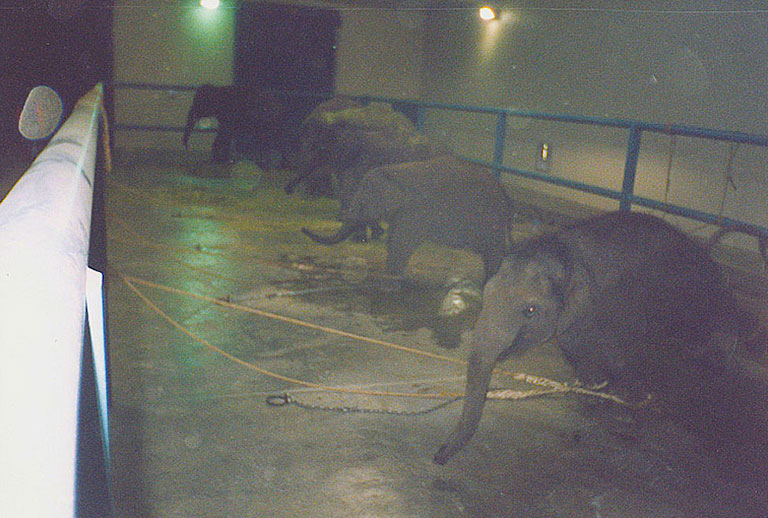
Unnatural Lives


In the wild, elephants are guarded and cared for by their mothers into their late teens. Elephant babies form very close bonds with their mothers, as well as with their aunts and the other members of their herd, which is made up of several related adult females and their offspring. All of the adults work together as a team to care for the young ones, and are led by a matriarch, who is usually the oldest and most respected female in the family group.
These relationships, as well as the friendships and social roles developed outside the family unit, all play an important part in an elephant’s social structure and sense of security. But elephants in the circus are taken from their mothers as young as one year of age and never know such nurturing.
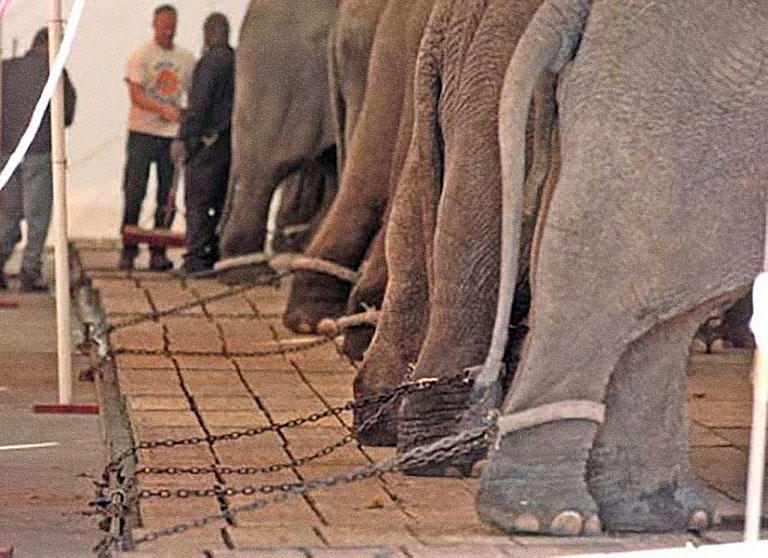
They also never know a natural environment. In the wild, elephant groups form large, social herds that walk up to 25 miles a day. But elephants in the circus, when they are not performing, languish in chains and unnatural confinement. They spend much of each year on the road, chained in trucks or boxcars and transported from city to city through all temperature extremes. Denied the opportunity to maintain important familial and social bonds and to explore and express instinctive behaviors in a natural setting, these intelligent animals experience severe emotional suffering. Circus elephants regularly exhibit abnormal behaviors indicative of psychological distress, including repetitive rocking, swaying, and head-bobbing.
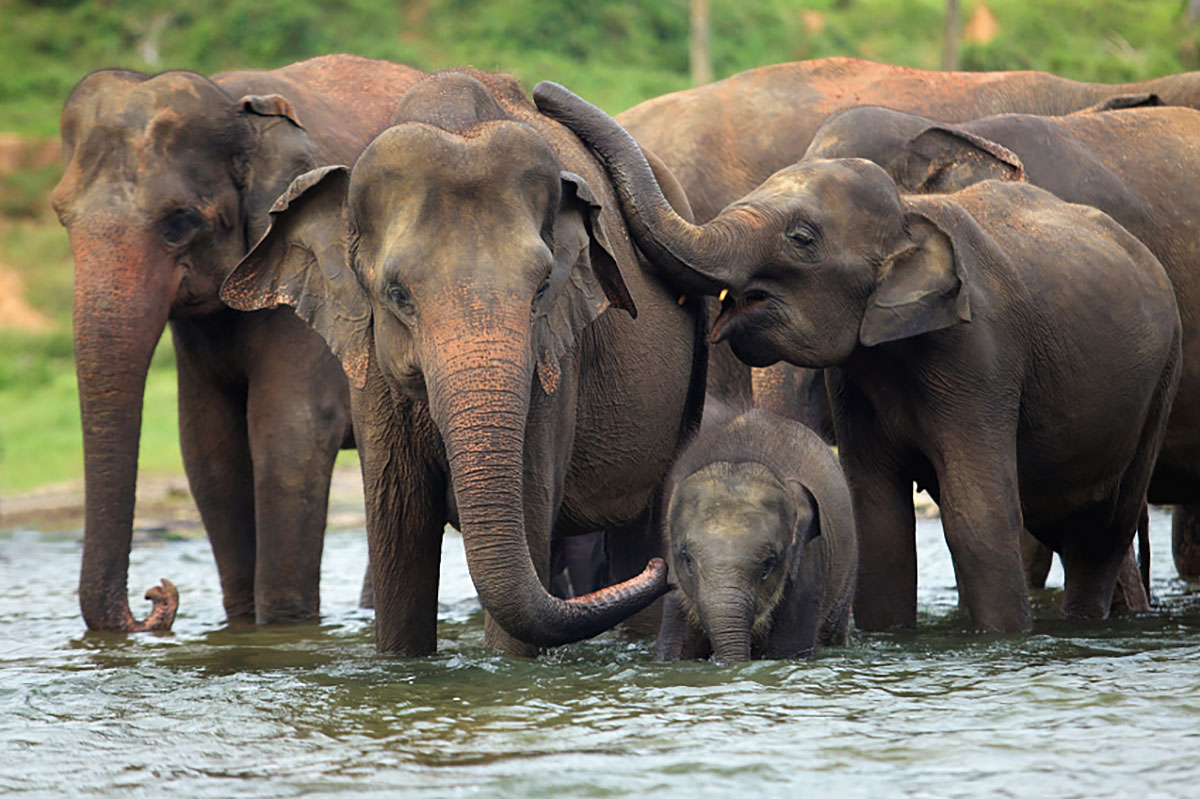
Abuse and Neglect

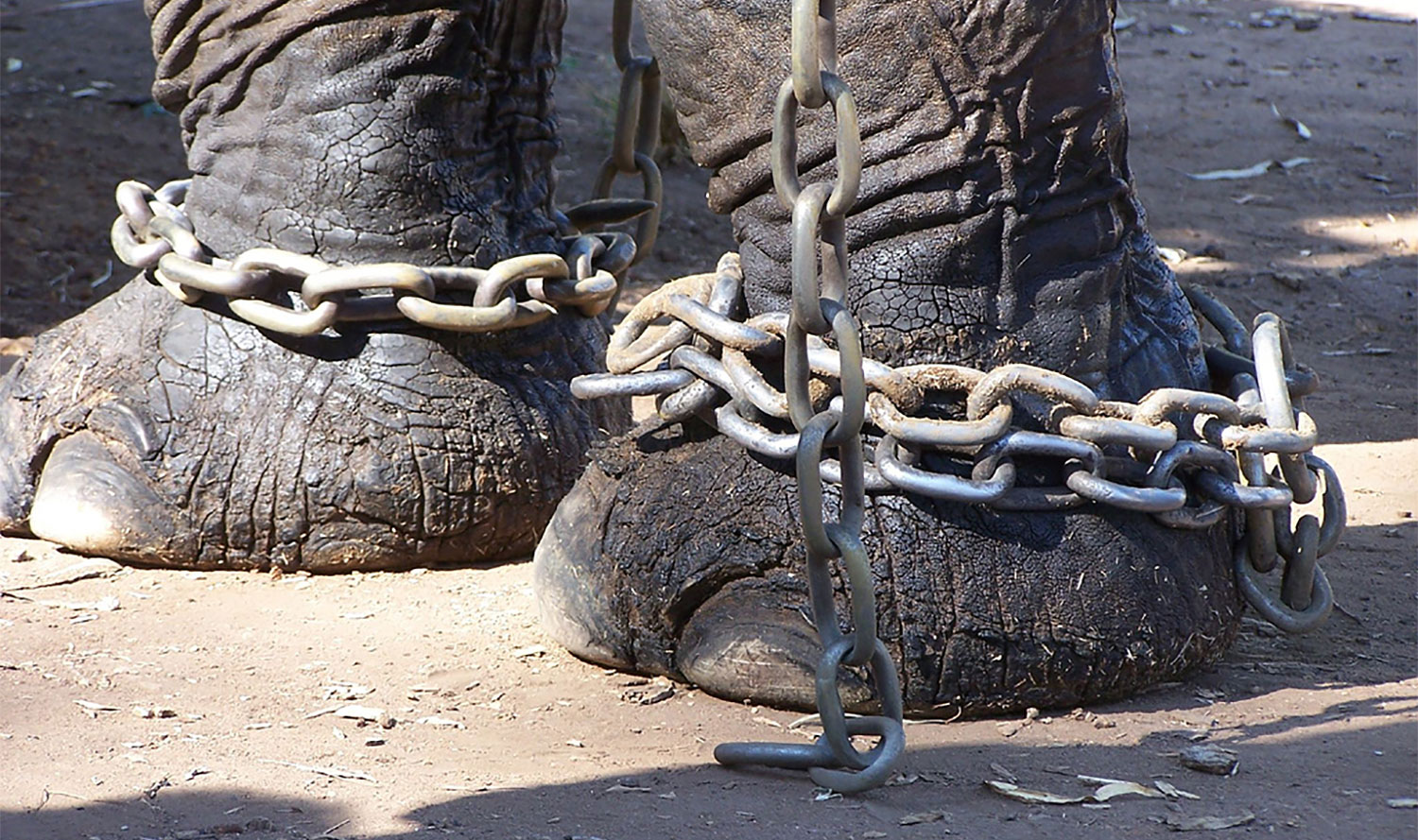
In addition to their ongoing inhumane training routine, elephants in the circus are frequently beaten. In a 2009 investigation, undercover investigators recorded eight Ringling Bros. and Barnum & Bailey employees, including the head elephant trainer and the animal superintendent, repeatedly hitting elephants on the head, trunk, ears, and other sensitive body parts with bullhooks and other cruel training devices. Investigations into other circuses reveal the same abuse. A Last Chance for Animals investigator documented extreme cruelty inside the Carson & Barnes Circus, including elephants being beaten with baseball bats, pitchforks, and other objects; shocked with electric prods, and hit on the head and across the face.
In March of 2015, footage of a UniverSoul Circus performance in New York City showed elephants visibly in distress. All were swaying back and forth in a behavior called “head bobbing”, a result of severe mental distress and anxiety. In 2011, Feld Entertainment, the parent company of Ringling, was ordered by the USDA to pay $270,000—the largest civil penalty ever assessed against an exhibitor—for dozens of Animal Welfare Act violations, including failure to provide animals with veterinary care. Elephants in the circus frequently suffer from illness and injury which are exacerbated by inadequate veterinary treatment. Animals are often forced to perform despite sickness, chronic pain and lameness. Prior to retiring their elephants from shows in 2016, Ringling Circus received multiple citations from the USDA each year for two decades, for failing to comply with humane treatment laws. From 1992 until 2016, at least 30 Ringling elephants, four of them babies, died, including an 8-month-old baby elephant named Riccardo who was destroyed after he fell from a circus pedestal and fractured his hind legs.
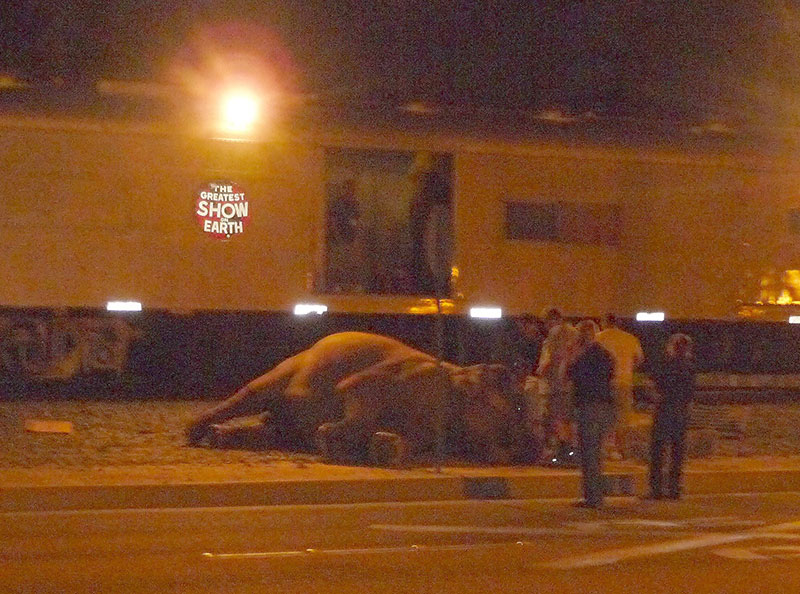
Sarah the elephant collapsed while being loaded into a boxcar in Anaheim, California. She had been forced to perform despite Ringling’s knowledge of her serious health problems
In the summer of 2015, audience members at a circus in Belrus watched in horror as an elephant fell from the top of a six-foot pyramid of stools. The other elephants in the circus rushed to his side to comfort him while the people in the front rows, whom the elephant missed by a mere few feet, scrambled to get out of the way.
The Traveling Circus

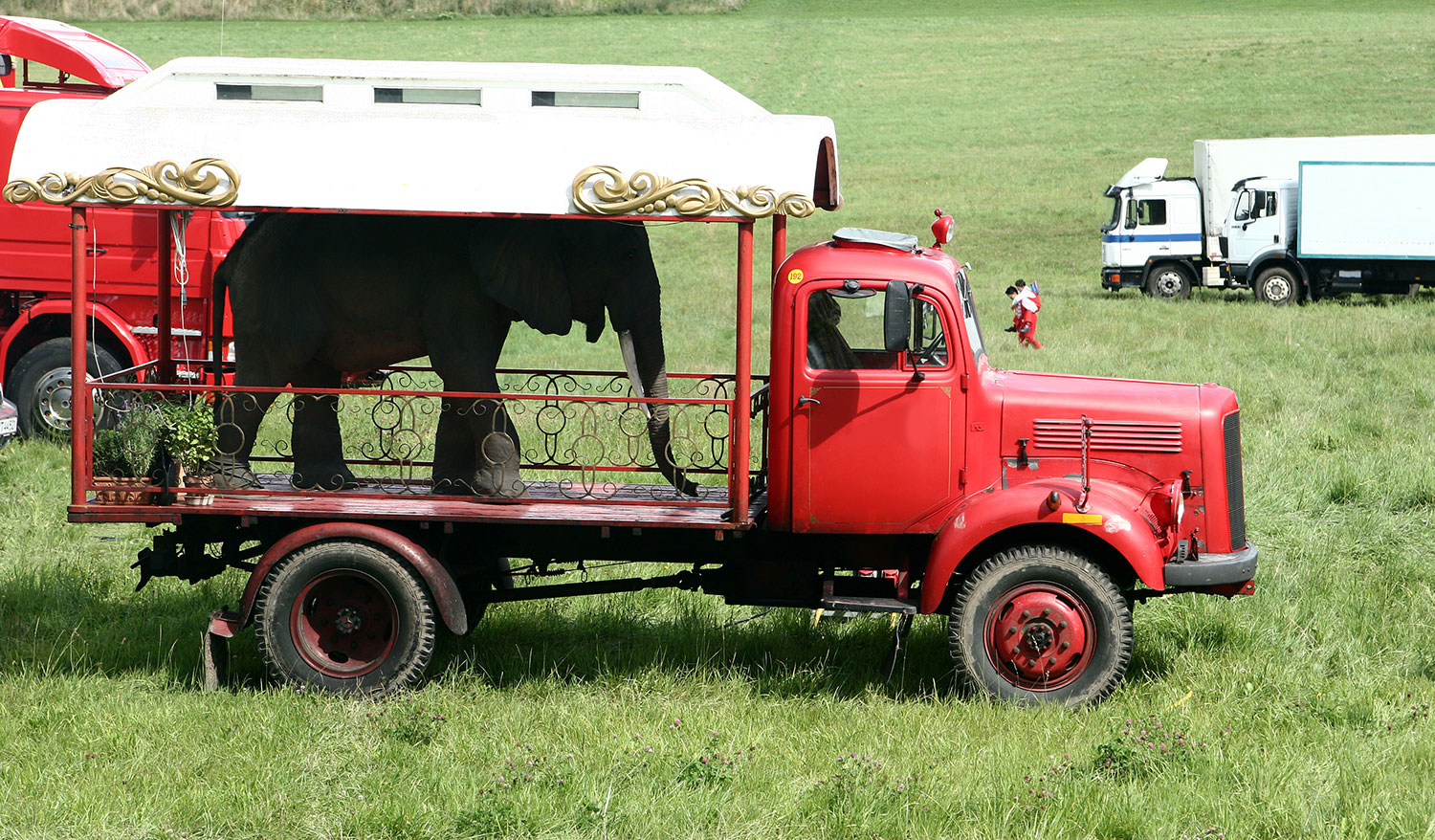
There are currently 19 traveling circuses in the U.S alone, which have approximately 65-69 elephants. Travel for these circuses is becoming increasingly difficult as exhibitions with performing elephant acts are prohibited in many cities across 18 states, and several additional states restrict the use of specific instruments that are used to make exotic animals perform. It is completely unnatural for them on so many levels. They are often in extreme confined conditions, and are prone to health, behavioral and psychological problems. There is currently a push to pass the Traveling Exotic Animal and Public Safety Protection Act (TEAPSPA), as these captive animals often live in horrendous conditions and do not belong on the road.
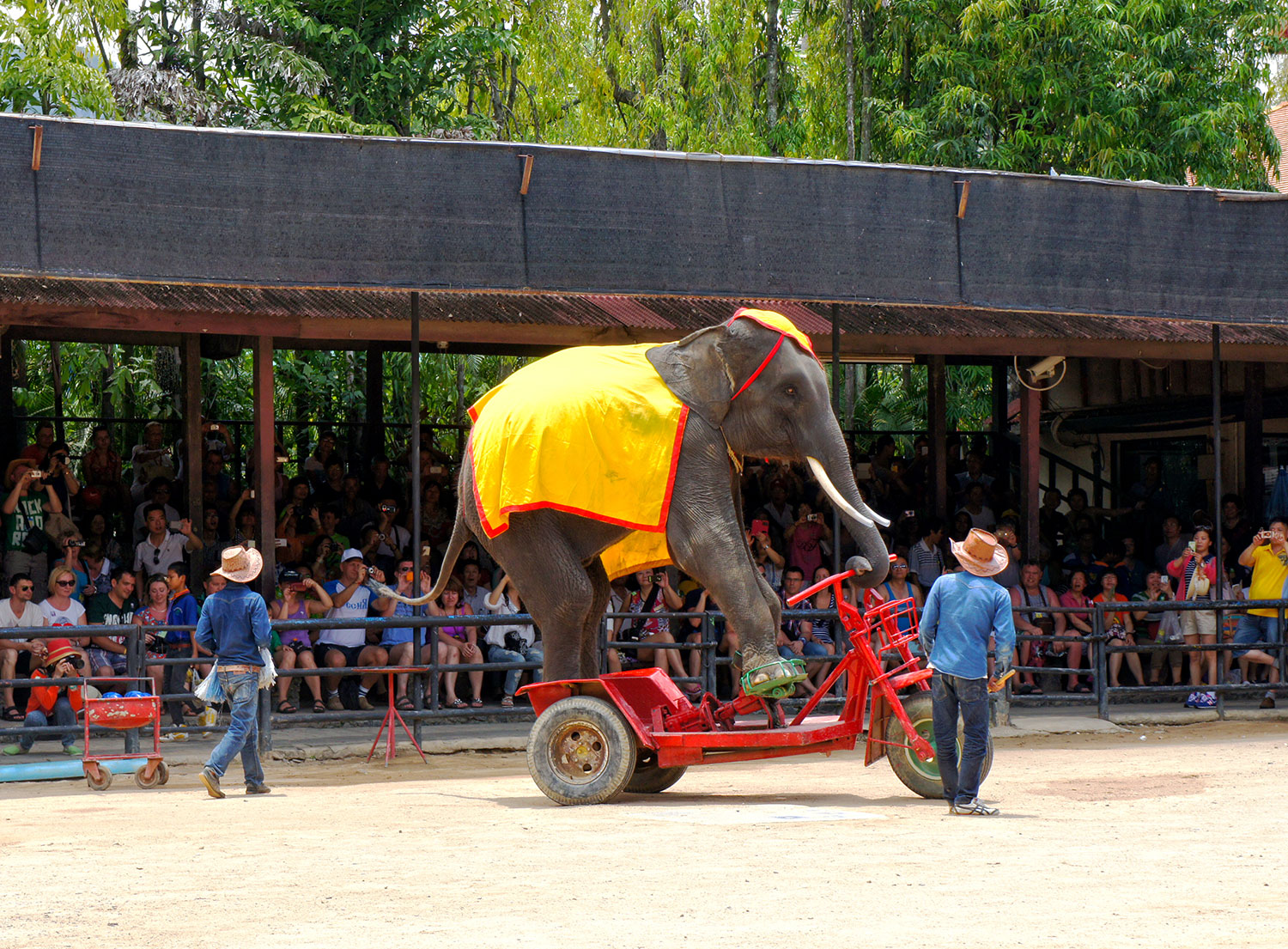
Elephant Experts Call for Ban

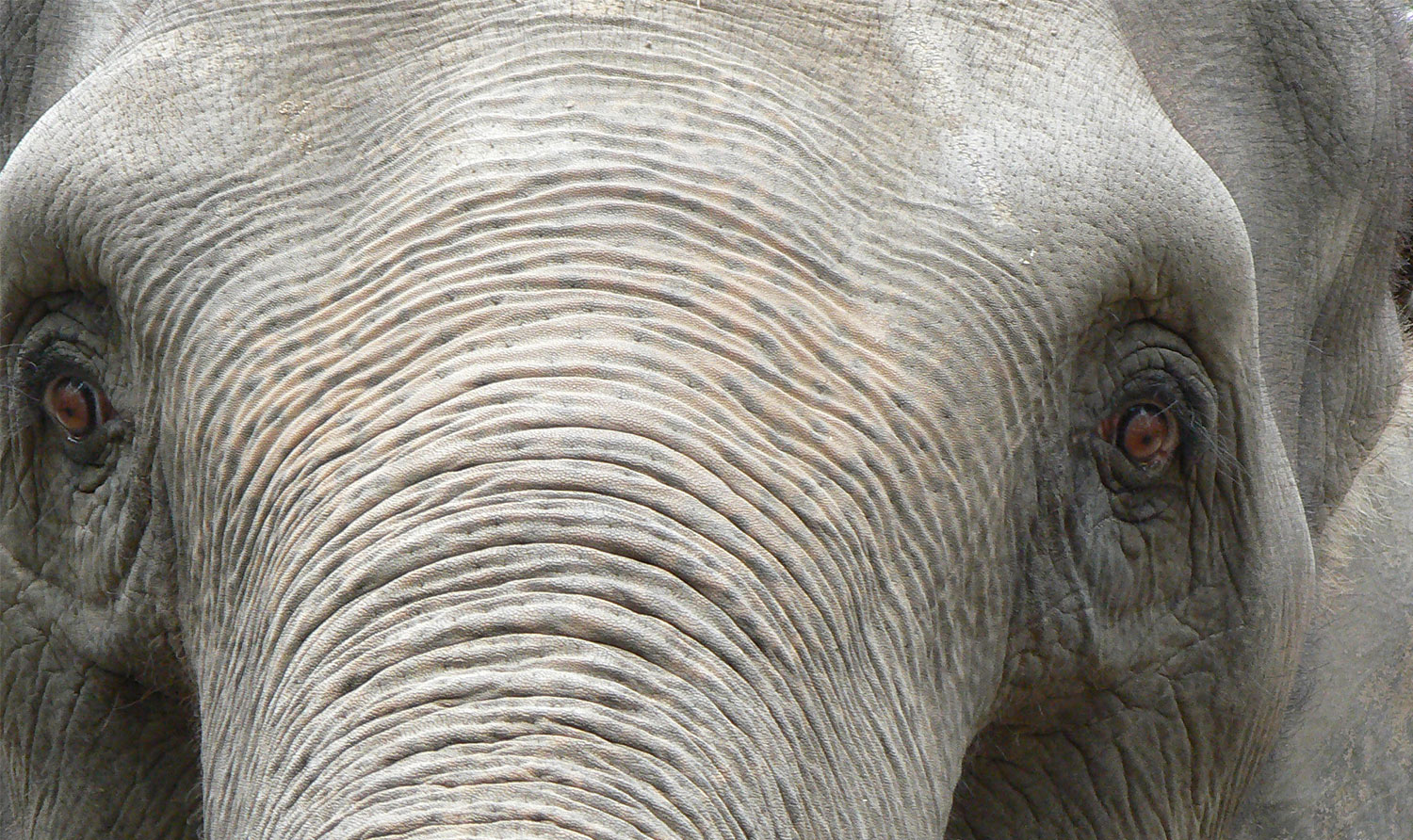
In 2008, the world’s leading experts in elephant research collaborated on an official statement for The Elephant Trust regarding the use of elephants in the circus. They wrote:
It is our considered opinion that elephants should not be used in circuses. Elephants in the wild roam over large areas and move considerable distances each day. They are intelligent, highly social animals with a complex system of communication. An elephant family is led by the oldest female – the matriarch – and is bonded by kinship, affiliation, experience, great loyalty and affection. No captive situation can provide elephants with the space they need for movement or with the kind of social stimulation and complexity that they would experience in the wild.
We believe that such intelligent, socially complex and long-lived animals should be treated with respect and empathy. An elephant’s place is in the wild with its relatives and companions. The totally unnatural existence of captive elephants in a circus, which includes significant physical and emotional suffering, is a travesty. To allow this practice to continue is unjustified and unethical.
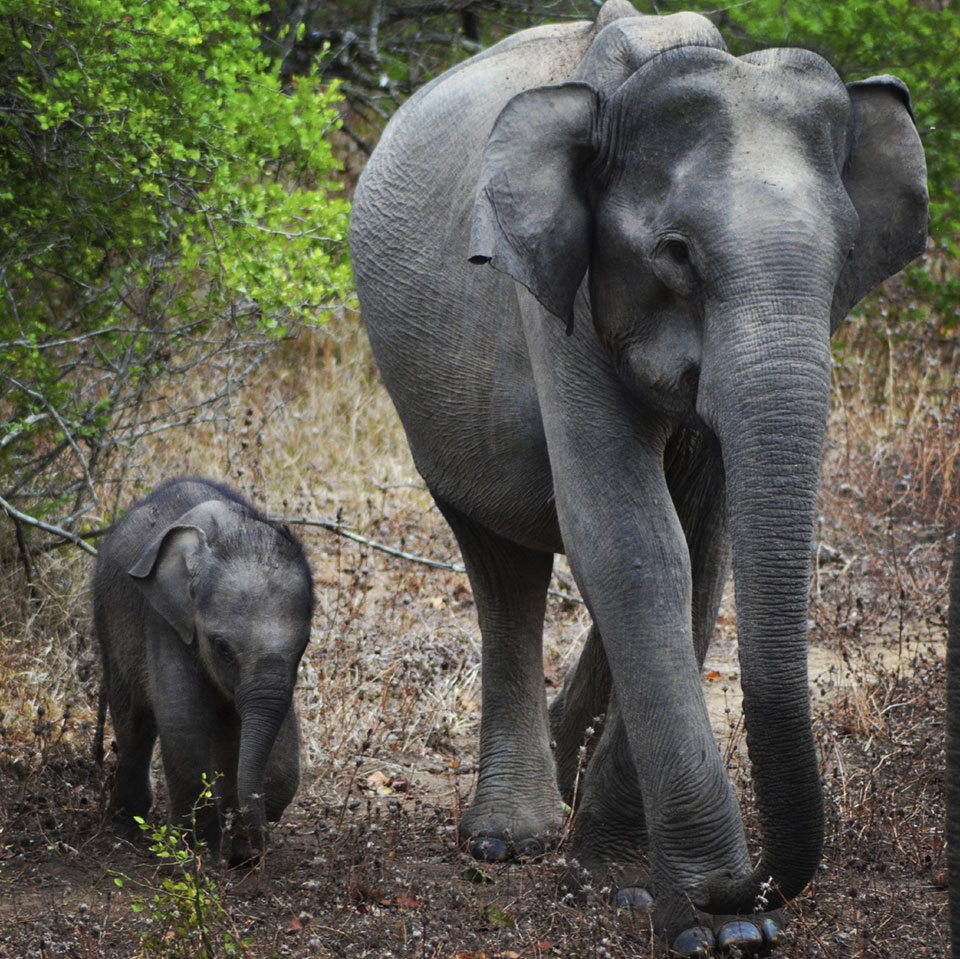
Life in the circus is a nightmare for elephants and other captive animals— but you can help bring an end to this exploitative tradition. Never attend circuses that use animals in their shows, and let your friends and families know why you don’t support performing animal circuses. Please visit our Action page to learn more about what you can do to be a part of positive change for elephants.
Life in the circus is a nightmare for elephants and other captive animals

Positive Change
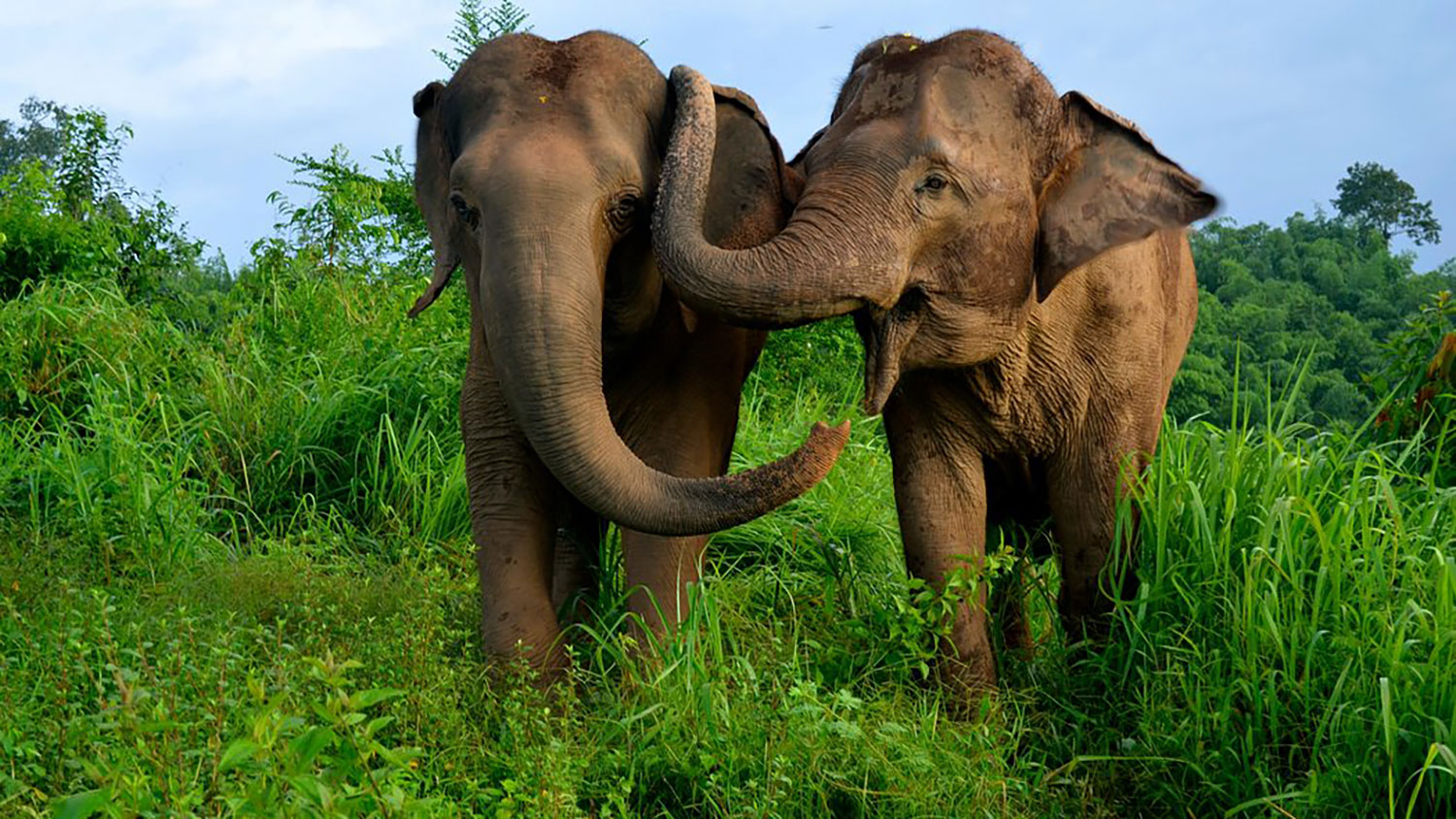
The Retirement of the Ringling Bros. Elephants

In May of 2016, Ringling Bros. Barnum & Bailey Circus retired their remaining show elephants, to a 200-acre retirement home in Florida. Feld Entertainment, the parent company of Ringling Bros., made the announcement in March of 2015, after intensive pressure from animal rights groups and slumping ticket sales. These factors combined with increased local legislation outlawing bullhooks and wild-animal performances, made it increasingly difficult for the circus. They originally announced that the elephants would stop performing by 2018, but the circus decided to retire the elephants sooner. In addition, Ringling Bros. closed the entire company in May 2017. Executives said the removal of the elephants instantly affected ticket sales, leading to their decision to close the 146-year-old company. “Since last May, when the elephants were taken off the show, the downward trend was much more severe than had been anticipated,” Kenneth Feld, chairman and chief executive of Feld Entertainment, said at a news conference at the company’s headquarters. “Over the past eight or nine years there’s been a decline, but when the elephants left the show we did not anticipate the impact that would have.” Although it’s great news about elephants retirement, and great for the other animals used in the circus, their “retirement” has been a subject of controversy. The elephants were moved to Ringling’s Center for Elephant Conservation, about 40 miles south of downtown Orlando, where they have been used in reproductive, geriatric and behavioral studies and pediatric cancer research. They claim that it is painless as they have only been using blood samples, but the truth is that they have still been exploited and it is not a true sanctuary. Furthermore they’re still chained at night and subject to electric prods. In September 2020, it was announced that White Oak Conservation Center in Florida purchased 35 retired elephants, to be moved to a new 2,500 acre habitat that will be completed in 2021. The massive habitat will be about four square miles, and will include forest, grasslands and many watering holes. The majority of the elephants will be transferred, but some of the older elephants will remain at Ringling’s Center, but their care and responsibility will be transferred to White Oak. Although the elephants are still captive, this is a happy ending for the elephants who are able to make the move.
Bans on Other Animal Circuses

For the animals used and abused in the circus, we’re still stuck in the Dark Ages. Thankfully, countries all over the world are stepping into the light and outlawing animal circuses. The more that concerned citizens exert public pressure and voice their opposition, the more this trend will continue. To date, more than 27 countries have completely banned the use of wild animals in the circus In the U.S. more than 150 cities and counties across 37 states have restricted or banned the use of wild animals in circuses, and traveling shows with more than 1/3 of those laws passing since 2014. For a full list of places that have banned the use of elephants and other animals in the circus, visit Animal Defenders International. For information on how you can help get animal circuses banned from your city, visit our Action page.
To date, more than 27 countries have completely banned the use of wild animals in the circus
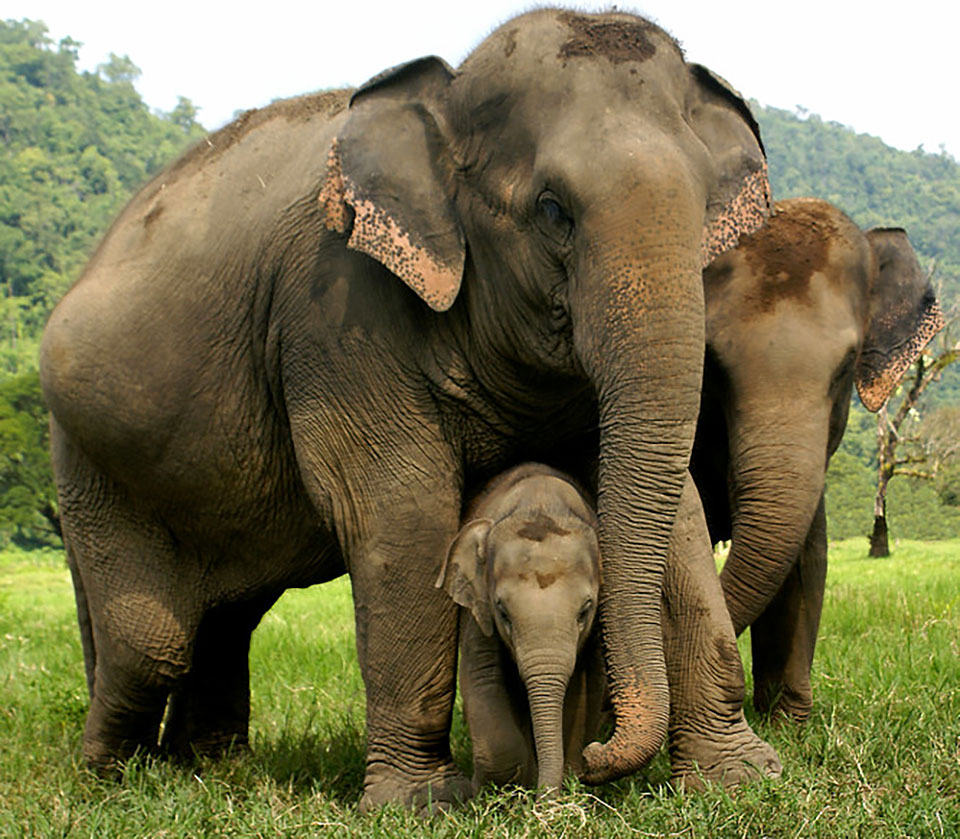
Rescue & Sanctuary

Elephant sanctuaries provide refuge and rehabilitation to elephants rescued from circuses, zoos, and other exploitative industries. Through outreach programs, sanctuaries also teach school children respect for wildlife and educate the public about the plight of circus elephants, as well as the many other crises facing elephants in captivity and in the wild. Many of these life-saving organizations are the result of one person’s dream and determination to make a difference for animals. Never underestimate the powerful impact one individual can have on the lives of animals who would otherwise have no one.
Never underestimate the powerful impact one individual can have on the lives of animals who would otherwise have no one
Elephant Sanctuary of Tennessee
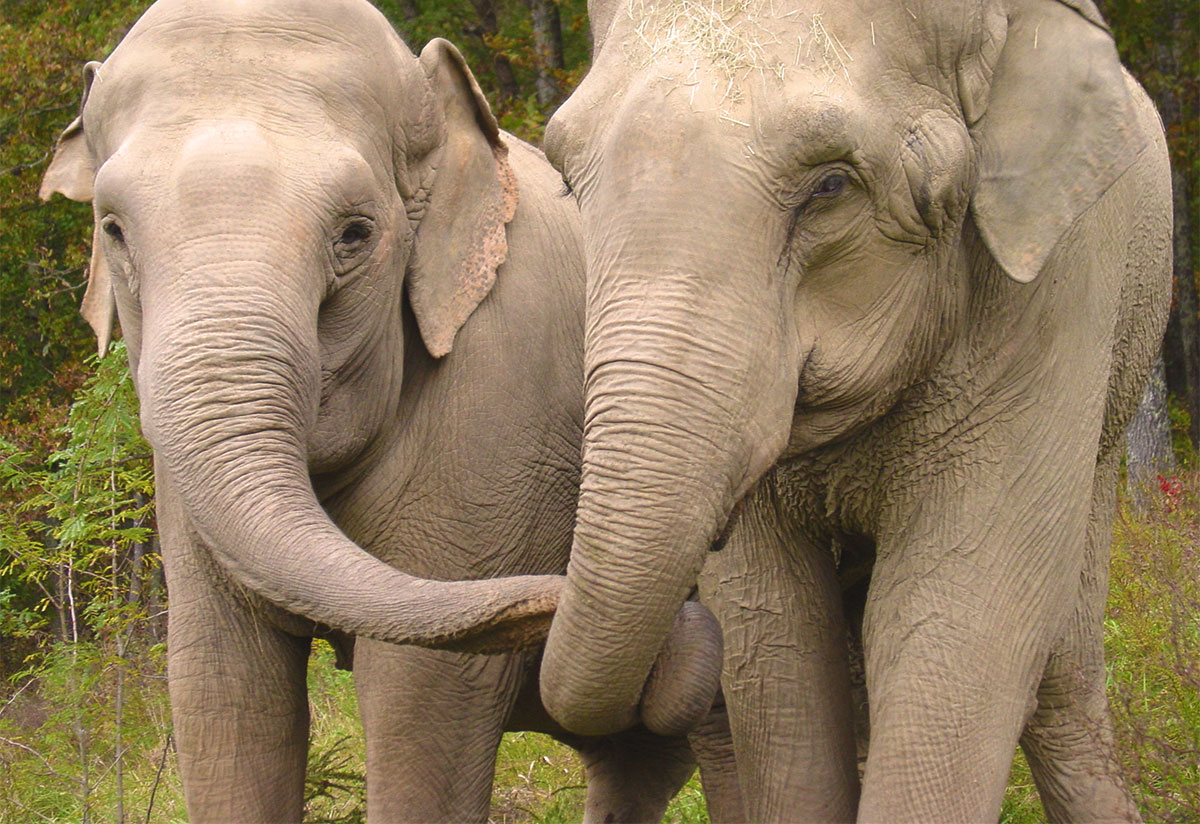
Elephant sanctuaries provide refuge and rehabilitation to elephants rescued from circuses, zoos, and other exploitative industries. Through outreach programs, sanctuaries also teach school children respect for wildlife and educate the public about the plight of circus elephants, as well as the many other crises facing elephants in captivity and in the wild. Many of these life-saving organizations are the result of one person’s dream and determination to make a difference for animals. Never underestimate the powerful impact one individual can have on the lives of animals who would otherwise have no advocates.
The Elephant Sanctuary of Tennessee, founded in 1995, is the nation’s largest natural habitat refuge developed specifically for endangered African and Asian elephants. Most of the elephant residents are rescued or retired from zoos and circuses and have never experienced a natural environment. The sanctuary provides elephants with 2700 acres of rolling pasture, dense forests, ponds, a 25-acre lake for swimming, and heated barns for cold winter nights. For most rescued elephants, this is the first time in their lives they’ve enjoyed the freedom to roam for miles on end and to form natural friendships and social bonds.
Elephant Refuge North America (ERNA)
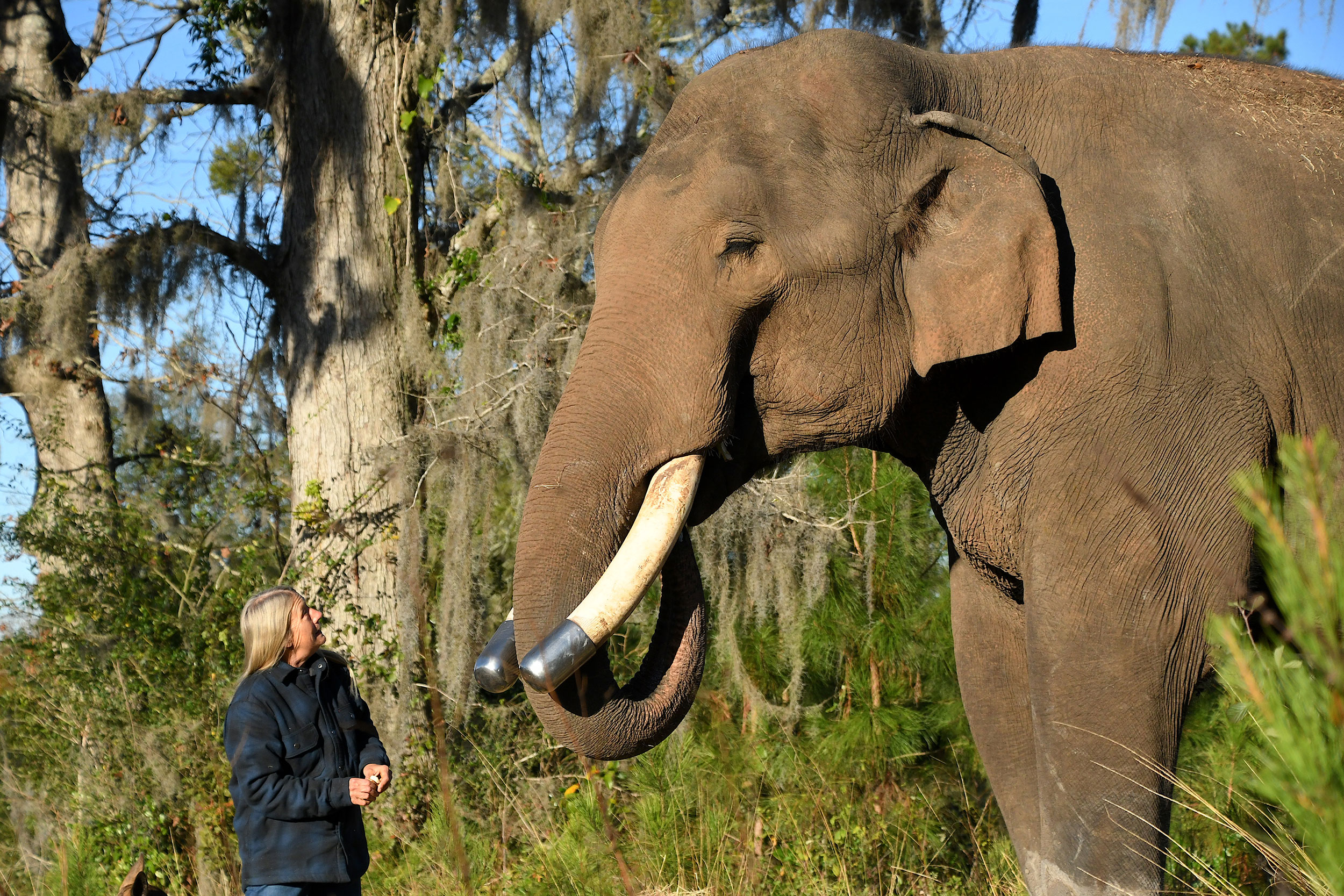
Carol Buckley, the founder of Elephant Aid International, and co-founder of Elephant Sanctuary in Tennessee, has created a new sanctuary for elephants, called Elephant Refuge North America (ERNA). The sanctuary, located in Attapulgus, Georgia, spans 850 acres of gently rolling hills, lush pastures, dense forests, spring-fed lakes, creeks, and streams. The climate in the region allows the elephants to remain outdoors 24/7 almost all year. The sanctuary is setting new standards of care for elephants in captivity. Elephant Refuge North America (ERNA) is currently home to two elephants, Bo and Tarra, and can accommodate as many as ten elephants retired from zoos and circuses. Mundi, an elephant currently living in a zoo in Puerto Rico, that has been closed for years, will soon call ERNA home, and will be the sanctuary’s third resident.
ARK 2000 (Performing Animal Welfare Society): America’s first elephant sanctuary
The Performing Animal Welfare Society (PAWS) maintains a 2300 acre natural habitat sanctuary in San Andreas, California, called ARK 2000, for rescued Asian and African elephants. Founded in 1984 by former Hollywood animal trainer Pat Derby and her partner, Ed Stewart, PAWS rescues and provides sanctuary to animals who have been the victims of the exotic and performing animal trades. PAWS investigates reports of abused performing and exotic animals, documents cruelty, and assists in investigations and prosecutions by regulatory agencies to alleviate the suffering of captive wildlife. The ARK 2000 sanctuary includes five extensive elephant habitats where rescued elephants are able to roam freely for miles each day, foraging and exploring the vast forests, swimming in lakes, and enjoying the sanctuary’s varied natural landscapes.
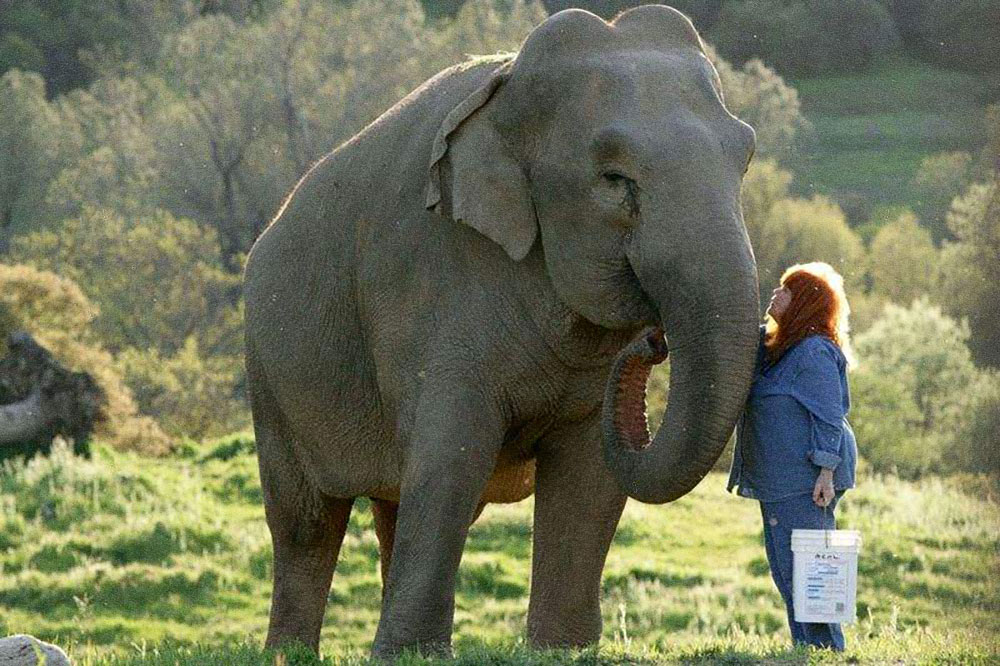
Wildlife SOS Elephant Conservation and Care Center
Located in Mathura, India, the Wildlife SOS Elephant Conservation and Care Center rehabilitates and gives a forever home to severely abused captive elephants rescued from the circus and entertainment industries. Here, elephants that used to spend their days doing hard work in harsh conditions are living out their retirement years in peace and safety. No longer forced to bear heavy loads, or walk on hot pavement, these majestic creatures are finally able to spend their days happily, with frequent baths, a nutritious diet, and veterinary care.
The center is full of natural vegetation and open fields with several trees. Free access to water pools have been provided for the elephants to bathe and play at any time of day. In November of 2015, two elephants, Mia and Sita, who had spent over 50 years chained up in a traveling circus, were rescued and transported over 1,200 miles to the Center. Their lives in the circus were so horrific that for long stretches of time, neither were allowed to sleep laying down. Upon arrival, the Center staff noticed an obvious change in their demeanors, as they became more energetic and happy—and Mia was noticeably thankful as she laid down for a nap for the first time. In April of 2016, Wildlife SOS rescued Rhea, a 55 year-old female elephant who had performed her entire life with Mia and Sita in the same circus, and reunited the three at the Wildlife SOS Elephant Conservation and Care Center.
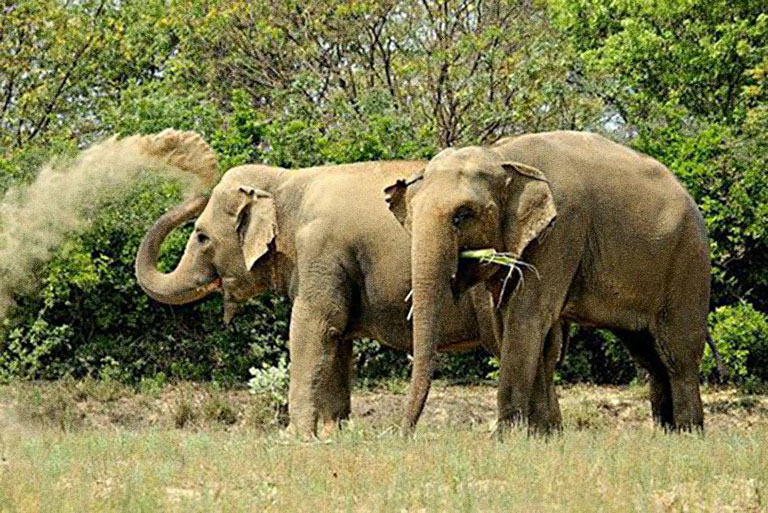
Elephant Research & Education

Several elephant interest groups have been working to promote better understanding and protection of elephants through scientific research and education. Organizations such as Elephant Voices and Think Elephants International work to publicize the extraordinary findings of elephant research through interactive websites and outreach campaigns that teach people about elephant communication, cooperation, learning, and the deep familial and social bonds of elephants, as well as their profound capacity for empathy and grief.
When an elephant becomes visibly upset, a nearby elephant will often approach the agitated animal and use its trunk to gently touch its face…
In a recent study entitled Asian Elephants Reassure Others In Distress, Dr. Joshua Plotnik of Think Elephants International found that Asian elephants regularly display “consolation behavior” around other elephants exhibiting distress. When an elephant becomes visibly upset, a nearby elephant will often approach the agitated animal and use its trunk to gently touch its face, or put its trunk in the other animal’s mouth. These findings have important implications for circus elephants, who, in addition to being routinely beaten in front of each other, are denied normal social interaction and the opportunity to form meaningful relationships with other elephants.
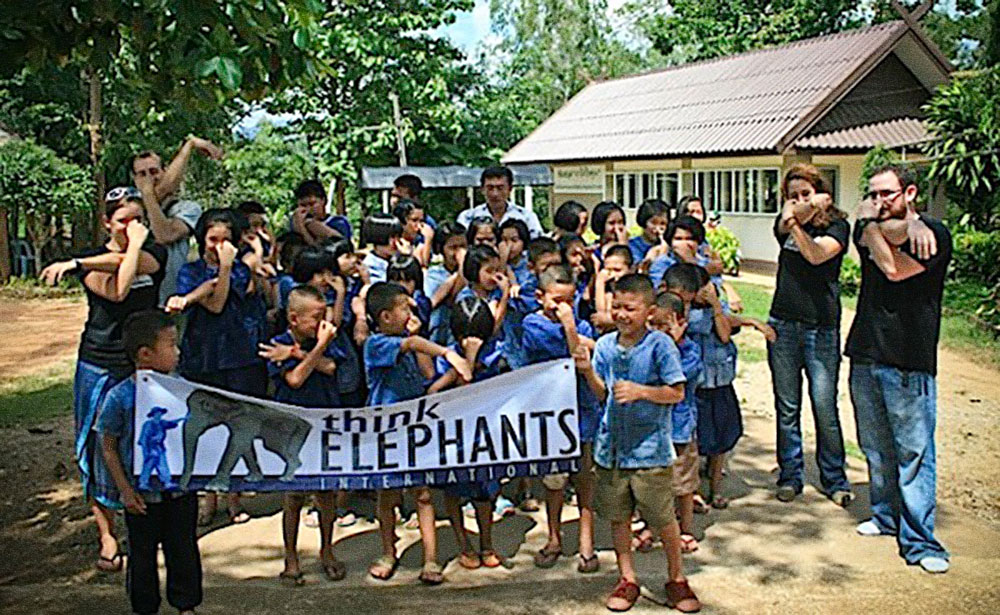
In addition to research, Think Elephants focuses extensively on education for children and teens, bringing elephant behaviorists and scientists into classrooms and partnering with after-school programs to implement exciting, interactive elephant conservation curriculum.
The researchers and collaborators behind Elephant Voices advocate for elephants via their website, scientific and popular articles, lectures, TV documentaries, interviews, radio broadcasts, and expert statement and testimony. The Elephant Voices educational website offers an extensive database of information on Asian and African elephants. Their images, recordings, studies, and multimedia projects form a remarkable resource being used by scientists and the public worldwide. Visit the interactive Elephant Voices site to learn about elephant communication, memory, intelligence, emotion, family life, and social structure.
Elephant Advocacy & Protection Groups

The plight of circus elephants is increasingly a topic of public dialogue and news headlines, and the focus of many animal protection campaigns and organizations. If you would like to support or become involved with an elephant protection group, our Explore section features a list of organizations working tirelessly on behalf of elephants.


Action
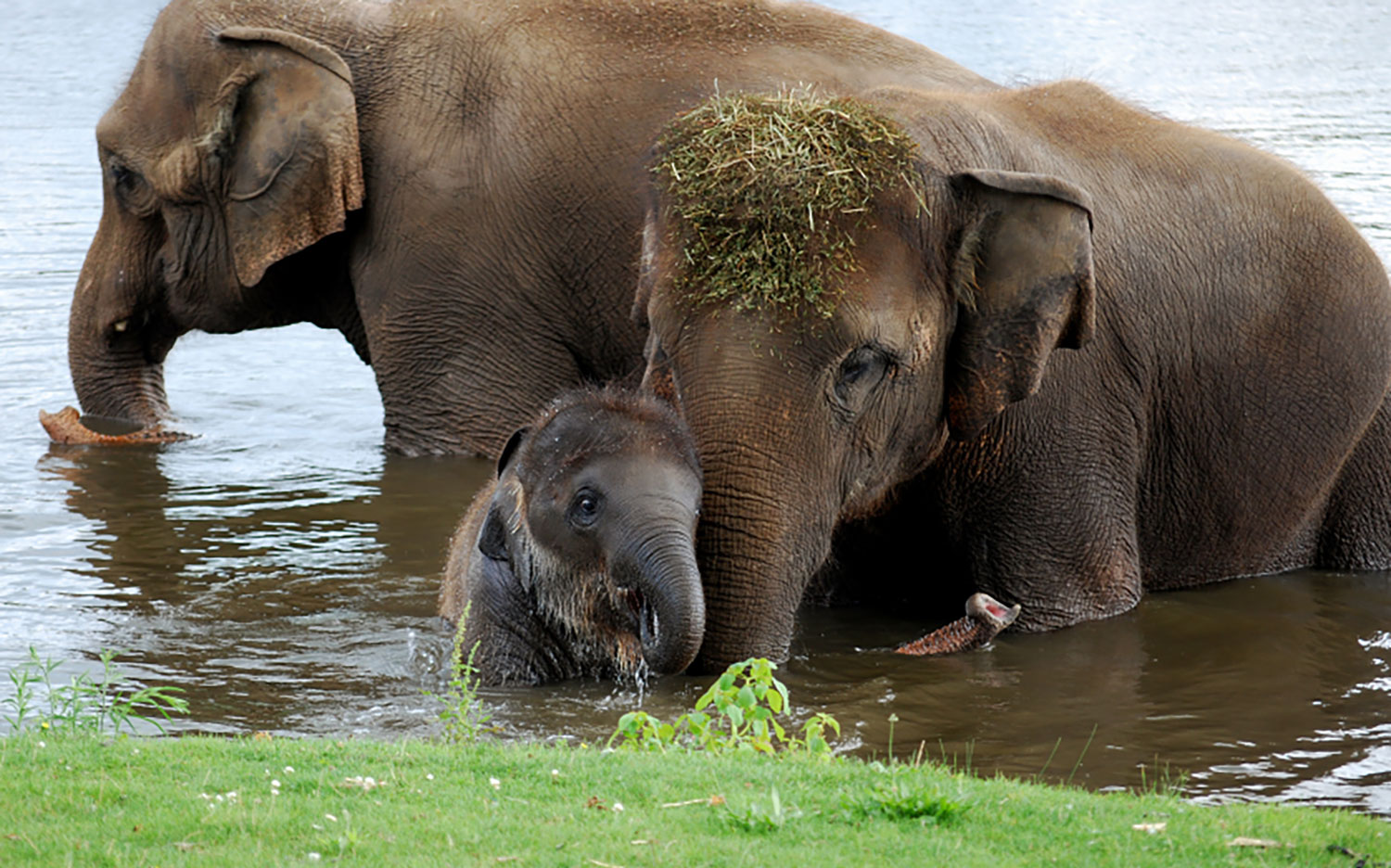
You can help end the suffering of elephants used in the circus. By choosing to take action on behalf of these mistreated animals, you become part of a worldwide effort that is making animal circuses a thing of the past. Here are some ways that you can help:
Do not attend circuses that use animals

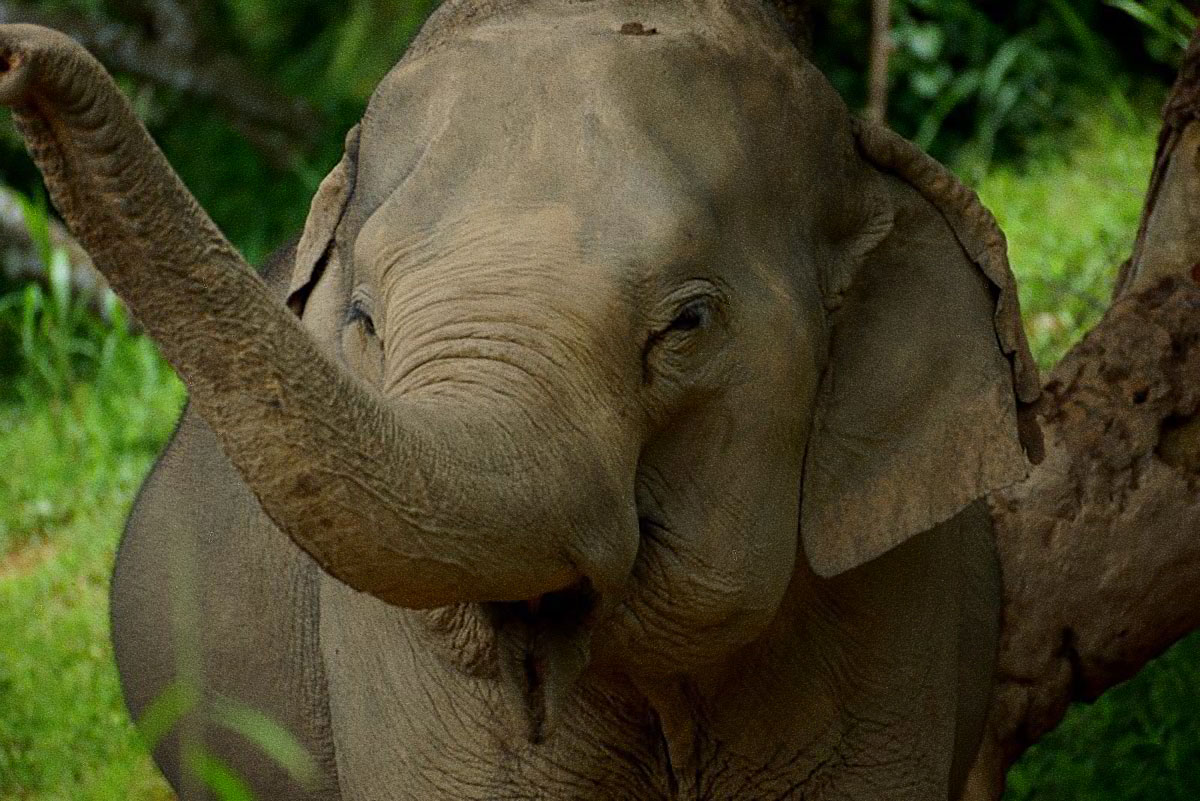
Educate friends and family about how elephants in the circus are treated.
Contact your elected officials

Call or write your mayor and other elected representatives and ask them to enact a ban on animals in circuses within your city or state limits. To find your elected state and local officials, visit congress.org and type in your zip code.
Support the Traveling Exotic Animal and Public Safety Protection Act (TEAPSPA)

The U.S. lags far behind many other countries that have outlawed the use of animals in the circus. Traveling Exotic Animal and Public Safety Protection Act (TEAPSPA) represents federal legislation introduced by Congressman Jim Moran to end the use of wild animals in traveling circuses. If you would like to write your own personalized letter, details including talking points and sample letters and details including talking points can be found here.
Join a Stop Circus Suffering campaign

Stop Circus Suffering is a global campaign by Animal Defenders International to end the suffering of animals in circuses. The campaign is built on evidence collected by ADI field officers working undercover in circuses all over the world. ADI’s global campaign has been instrumental in the closure of many circuses and performing animal centers, and in local and national bans on the use of animals in circuses. Find out how you can help a Stop Circus Suffering campaign by visiting their international page and clicking on your country.
Stop Circus Suffering is a global campaign by Animal Defenders International to end the suffering of animals in circuses.
Organize a protest or leafleting event

Find out when the circus will be in your town and organize leafleting sessions in the weeks leading up to the event. Animal Defenders International will provide you with their free “Stop Circus Suffering” leaflets, which are great to hand out to passersby and to leave in public spaces like libraries, restaurants, and grocery stores. You can also hand these out at the circus venue on the days of the show to help inform circus-goers of what they’re really paying for. If you would like help organizing a demonstration, or to order free educational leaflets, posters, or any other materials you may need, email ADI at usa@ad-international.org
Post information about circus elephants on social media sites

Many of the elephant rescue and advocacy organizations we link to have Facebook and Twitter accounts. Follow their pages and share photos and posts with your friends and family. Note that it’s important to share positive stories and images of elephants, in order to help people connect with these animals and to keep them inspired.
Write a letter

If a circus is scheduled to perform in your city, start a public dialogue by writing a letter to your local newspaper editor about animal abuse in circuses.
Sponsor a Billboard Campaign

You can educate people in your community about the suffering behind the scenes for circus animals by sponsoring a billboard when the circus is coming to town. Email usa@ad-international.org to find out how.

Support Elephant Sanctuaries & Elephant Advocacy Organizations

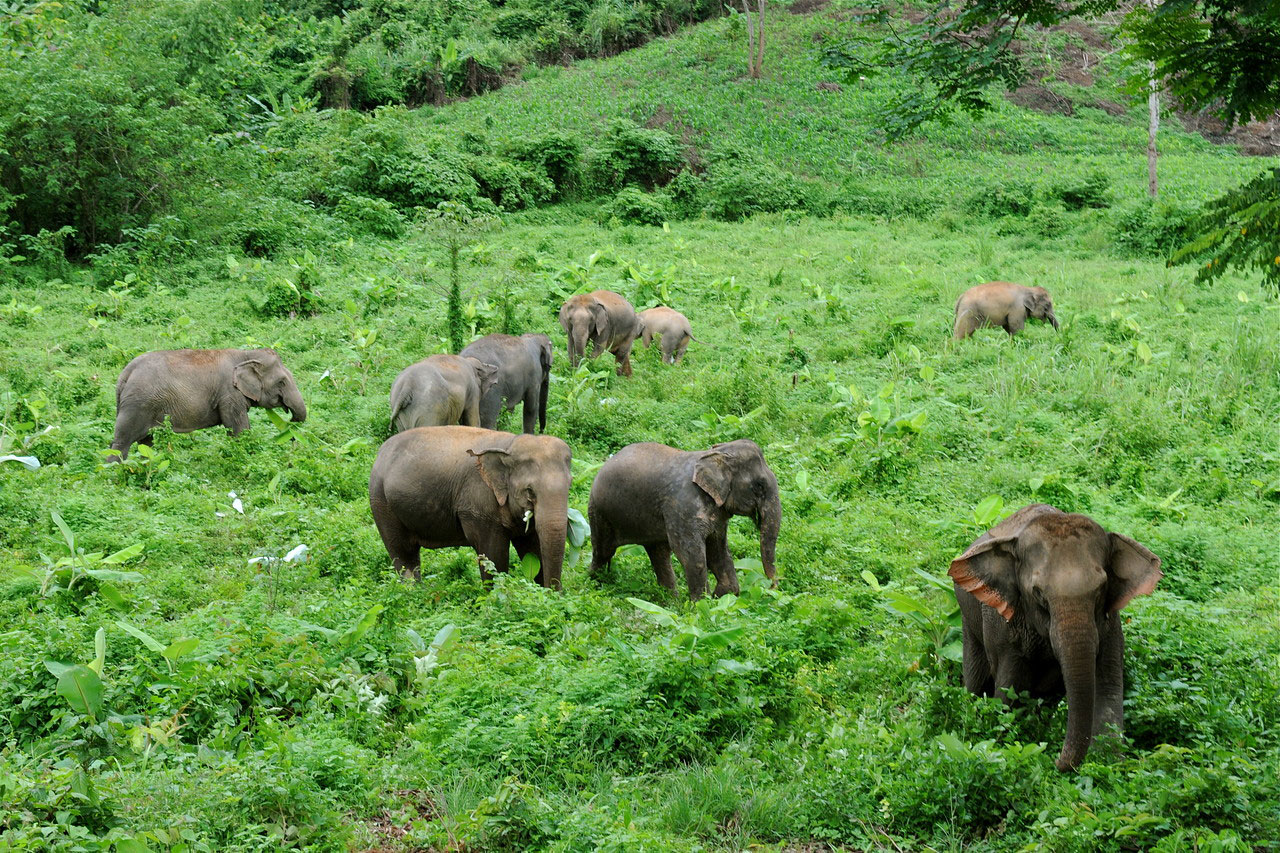
There are many reputable organizations advocating on behalf of Asian elephants and several sanctuaries providing rescued elephants with permanent refuge in a natural environment. These groups depend upon donor support for their ongoing advocacy and rescue efforts. Consider supporting organizations that are working to make a difference for elephants in the circus. These include:
The Elephant Sanctuary
Performing Animal Welfare Society
Global Sanctuary for Elephants
Animal Defenders International
Think Elephants International
Save Elephant Foundation
Elephant Voices
Save the Elephants
In Defense of Animals
The Elephant Reintroduction Foundation

Facts
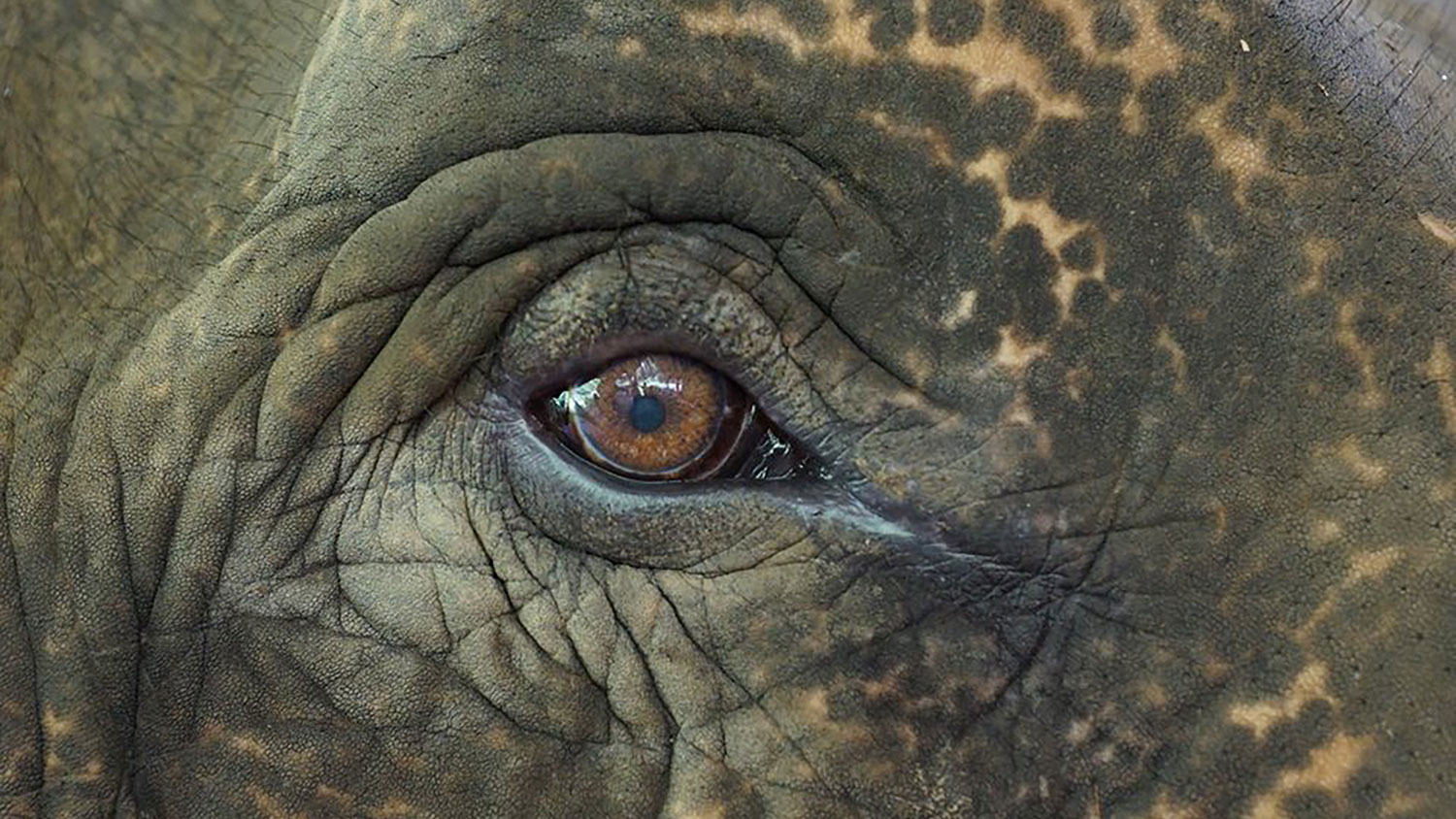
Elephants form some of the strongest social bonds of any animals. The extended family unit is made up of mothers, daughters, aunts, and other female relatives who stay together for their entire lives. But in the circus, whether they are captured in the wild or born on breeding farms, elephants are taken from their mothers at a very young age, sometimes as young as one year old.
The natural lifespan of an Asian elephant is 60 to 70 years. Captive elephants, however, do not typically live past the age of 40. Many elephants are destroyed due to captivity-related foot problems or arthritis. Between 1994 and 2005, at least 31 elephants died premature deaths in the circus.
Asian elephants are highly intelligent and sensitive animals. The physical punishment, intimidation, and unnatural conditions they endure in the circus typically result in the development of neurotic stress behaviors such as swaying and head-bobbing. Life in the circus can literally drive these animals insane.
Asian elephants are endangered. In 1900, there were about 100,000 Asian elephants worldwide. Today, there are an estimated 40,000 to 45,000 Asian elephants left, with almost 30% of these in captivity. Some circuses claim to promote conservation through their captive breeding programs, which they use to replenish their supply of performers, but none of the elephants born in these programs will ever be rehomed in the wild.
Elephants in the wild walk for up to 18 hours and 40 miles a day. They have a strong natural instinct to roam and explore. This behavior is constantly thwarted in the circus, where elephants spend up to 11 months a year on the road, nearly always chained or confined. The only form of travel they experience is on boxcars or trucks, being transported from city to city in all temperature extremes.
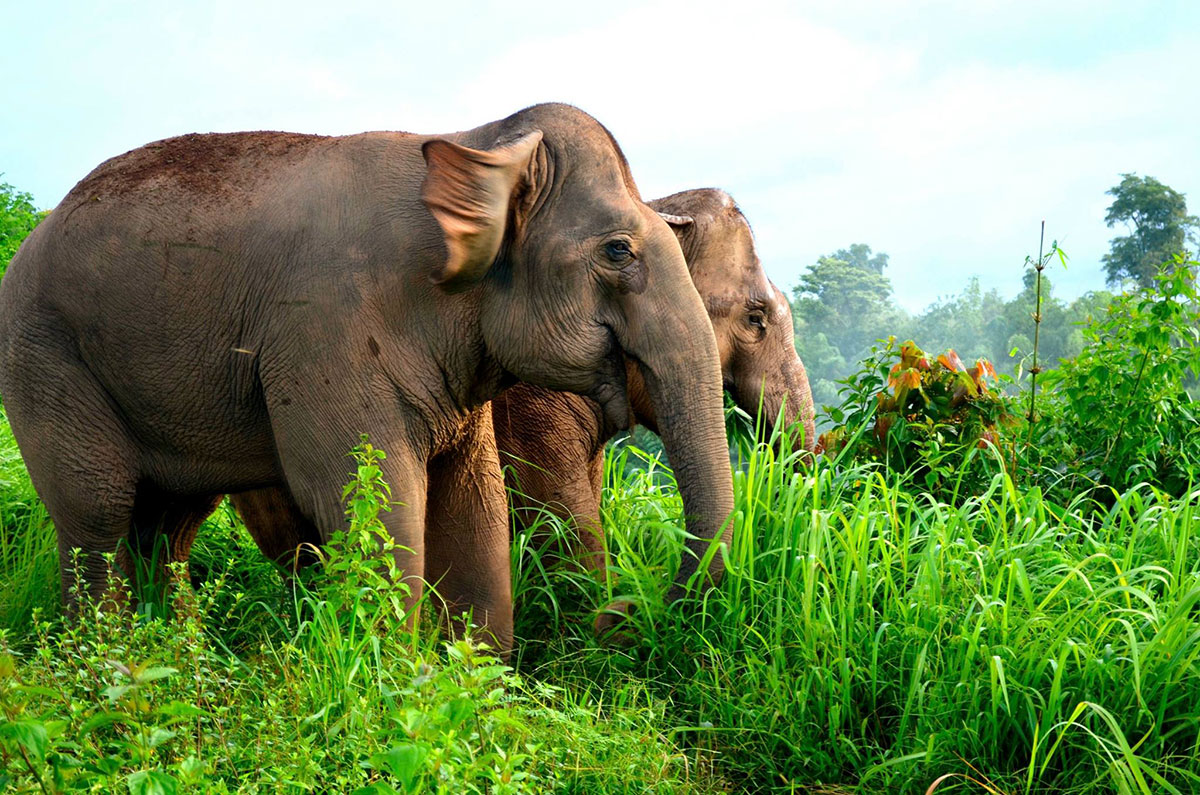

Explore
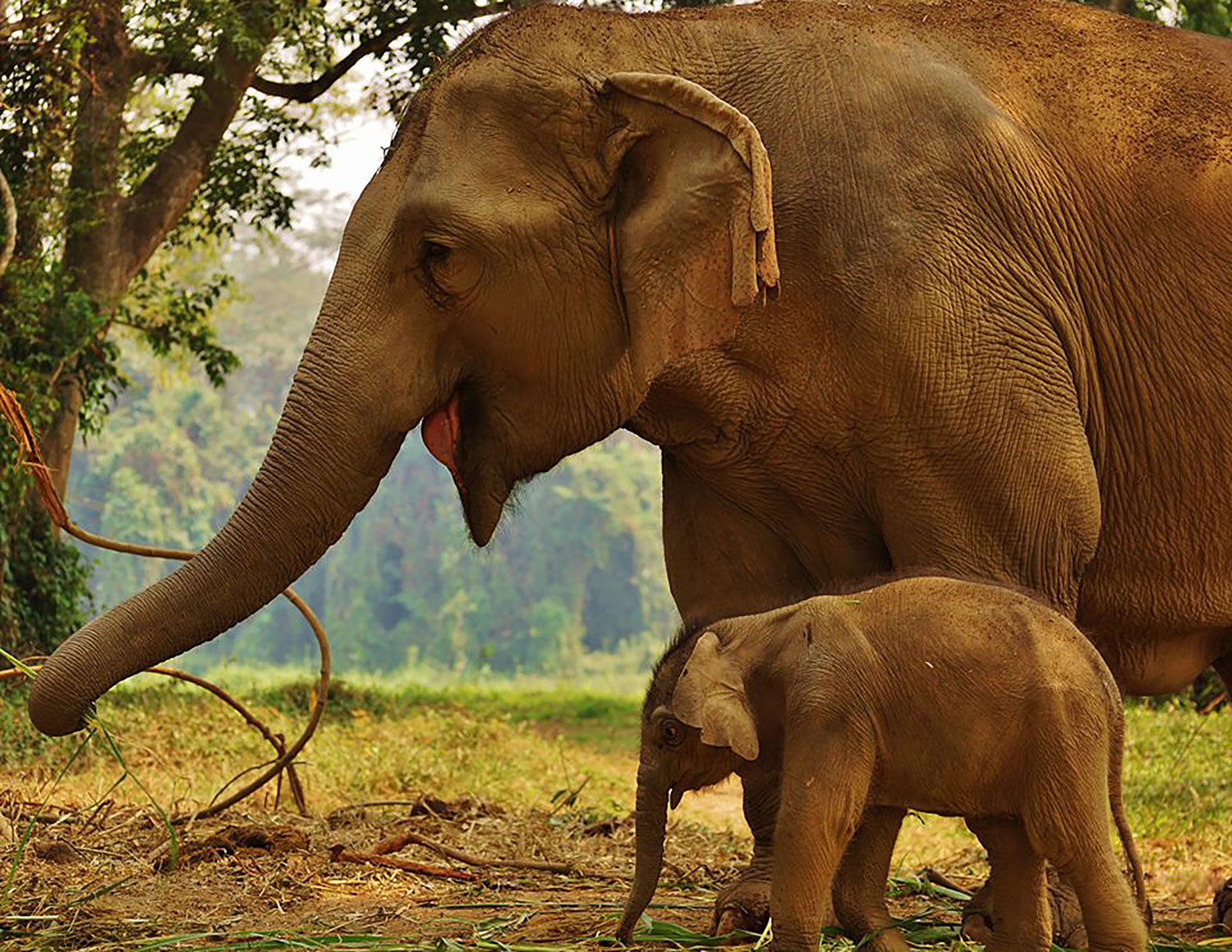
See

Learn more about elephants through these fun and fascinating clips.
Elephant play
There are few things elephants love more than water. Here the residents of Elephant Nature Park in Thailand are so ecstatic to play in the rain you’d think it was their first time!
Elephant families
The bond between mother elephants and their babies is one of the closest in the animal kingdom. Watch as this mother and her newborn go for their very first bath together in a creek.
You can visit the Elephant News YouTube channel for more elephant videos. Also check out the Elecam, the Elephant Sanctuary’s live streaming footage of rescued elephants in a natural habitat.
Listen

Elephant Lullaby
Elephants have a highly sophisticated form of communication that includes more than 70 kinds of vocalizations and 160 different visual and touch signals. They make a wide range of calls and sounds for different purposes, including trumpeting, squealing, chirping, screaming, rumbling, roaring, and even snoring. Watch this gentle elephant fall asleep to a lullaby at Elephant Nature Park sanctuary in Thailand:
Think Elephants International gives a fascinating example of how important context is to understanding the meaning of elephant vocalizations. Over at their website, you can hear Asian elephants rumbling, trumpeting, chirping and roaring, with detailed explanations of when these calls and sounds are used.
Elephant Voices offers an extensive database of elephant vocalizations compiled from decades of field research. Their educational website is a tremendous resource for those interested in learning more about elephant communication.
Interact

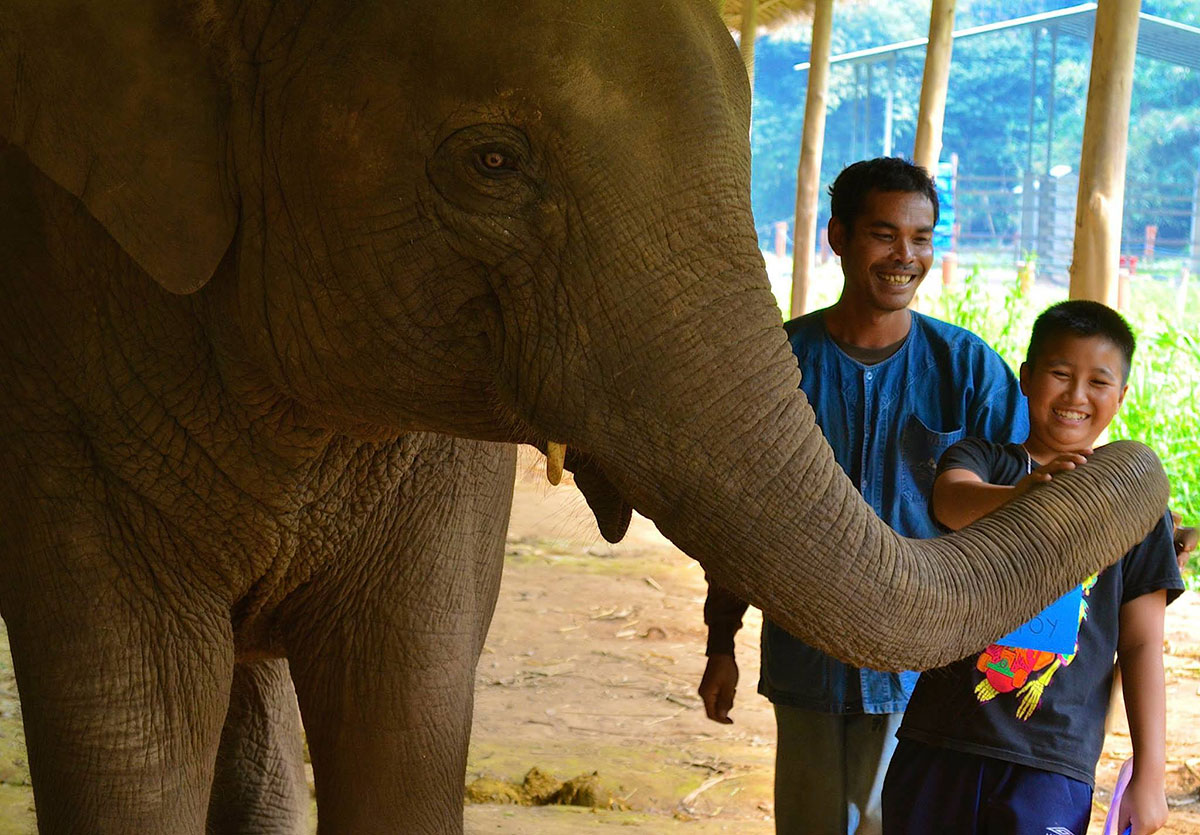
Even if you don’t live near an elephant sanctuary or advocacy organization, you can still be part of a community of compassionate people taking action for elephants. Most elephant interest groups have social media accounts such as Facebook and Twitter, where you will find inspiring news, posts, and a dedicated community working to make positive change for elephants.
Check out some of these groups!
Elephant Voices
Global Sanctuary for Elephants
Elephant Sanctuary
Performing Animal Welfare Society
Animal Defenders International
Think Elephants International
Save Elephant Foundation
Elephant Asia Rescue and Survival Foundation
In Defense of Animals
The Elephant Reintroduction Foundation
World Elephant Day
Learn

Bring elephants into the classroom!
The Global Elephant Sanctuary offers free online elephant lessons for all ages. Check out their educational pages for elementary, middle and high school students, as well as their elephant webquest projects.
The researchers at Think Elephants International have developed an interactive elephant-based curriculum for middle school students and their teachers. Additionally, they work with interested schools to arrange live webcam visits for classrooms with their elephant field site in Thailand. If you would like to learn more about their school programs, contact Dr. Jennifer Pokorny, Head of Education Programs, at jen@thinkelephants.org.
The Elephant Sanctuary in Hohenwald, TN offers virtual “visits” for classrooms or groups anywhere in the world. Non-intrusive sanctuary cameras allows students to observe elephants in the nation’s largest natural habitat for Asian and African elephants. Viewers are able to experience natural elephant behavior in a wild setting and to become familiar with the elephants’ history, habits, and how moving to the Sanctuary has changed their lives.
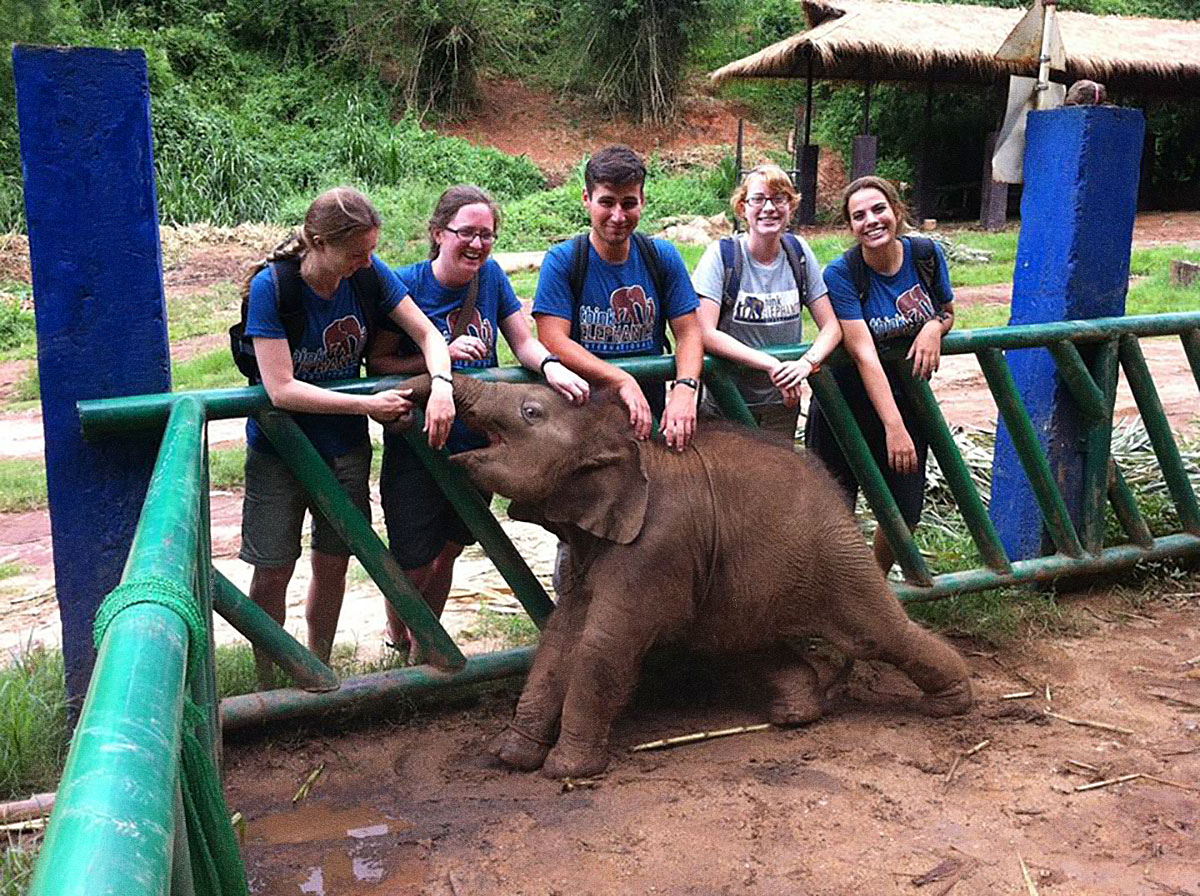
Watch

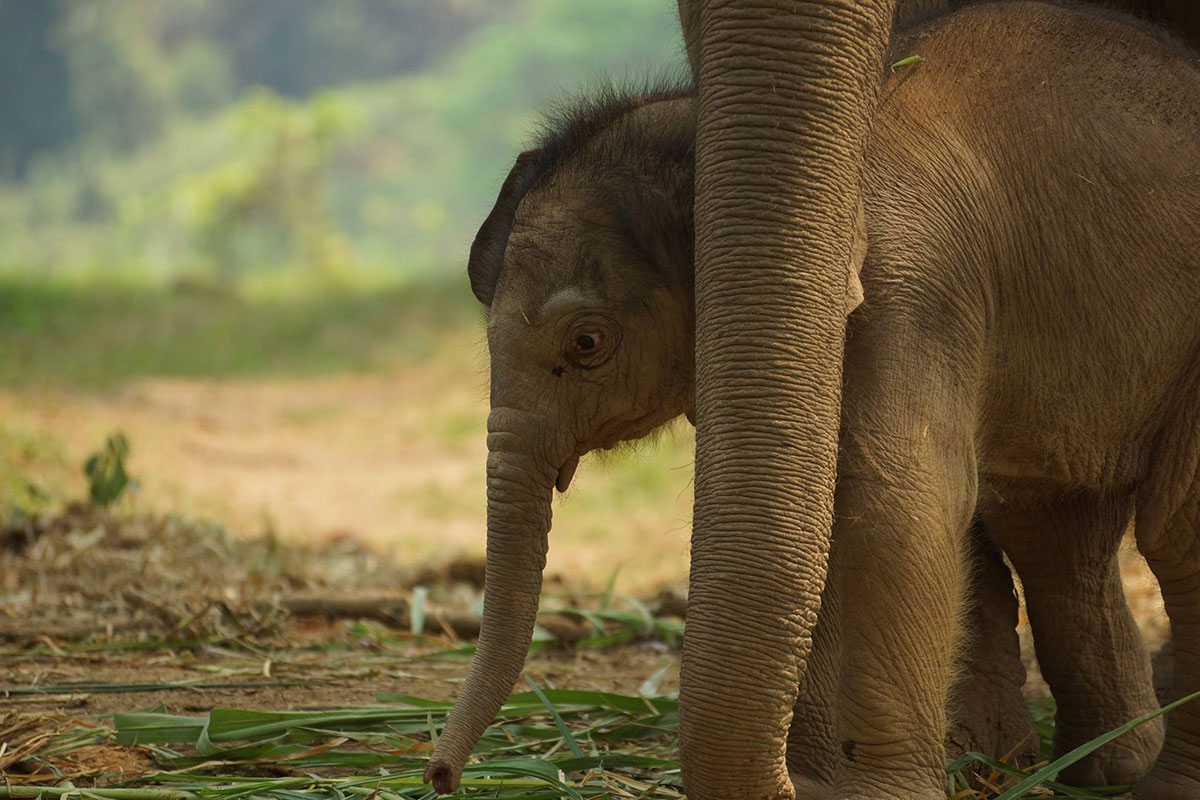
The following documentaries offer a glimpse into the lives of Asian elephants and elephants used in the circus:
Elephas Maximus: The Biology and Conservation of the Asian Elephant
The Last Elephants of Thailand
The Urban Elephant
An Apology to Elephants
An Apology to Elephants
